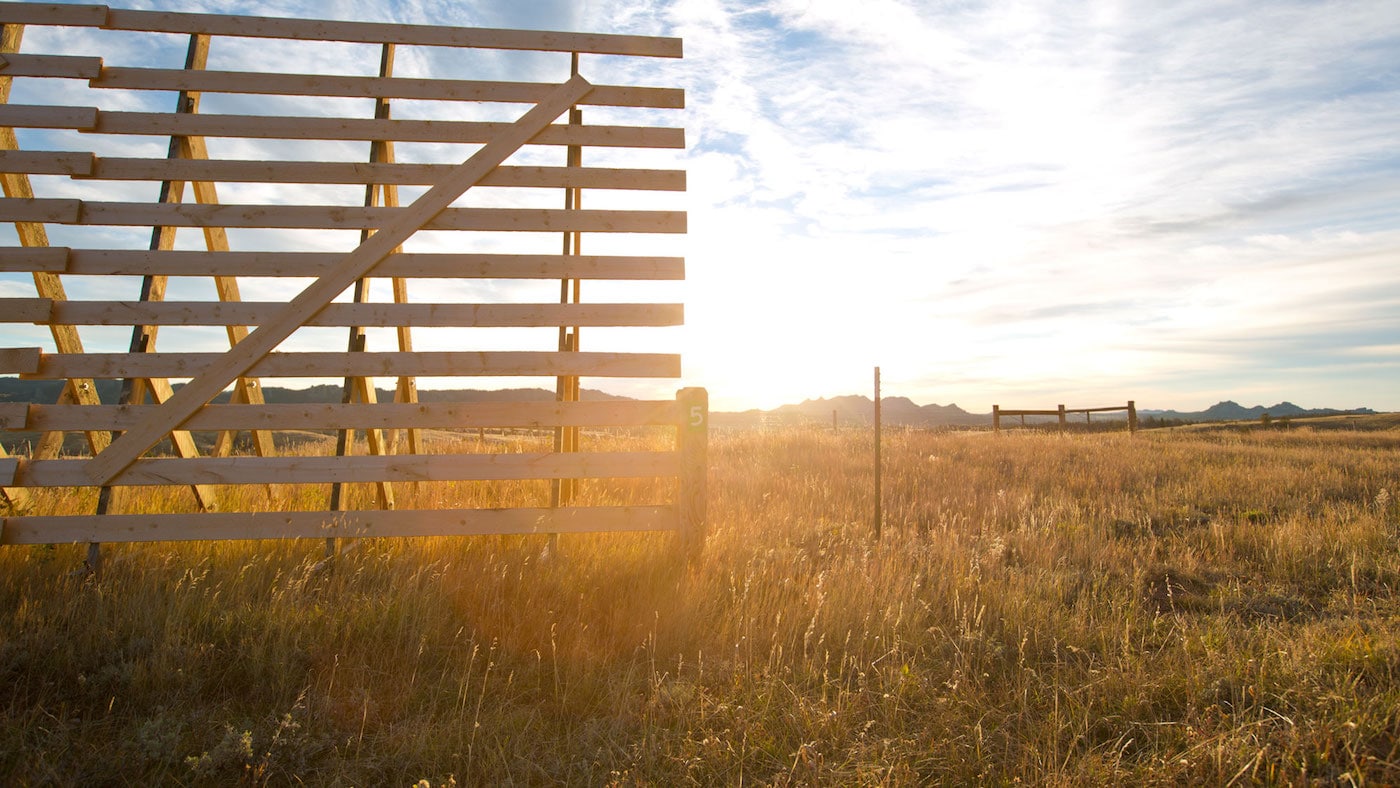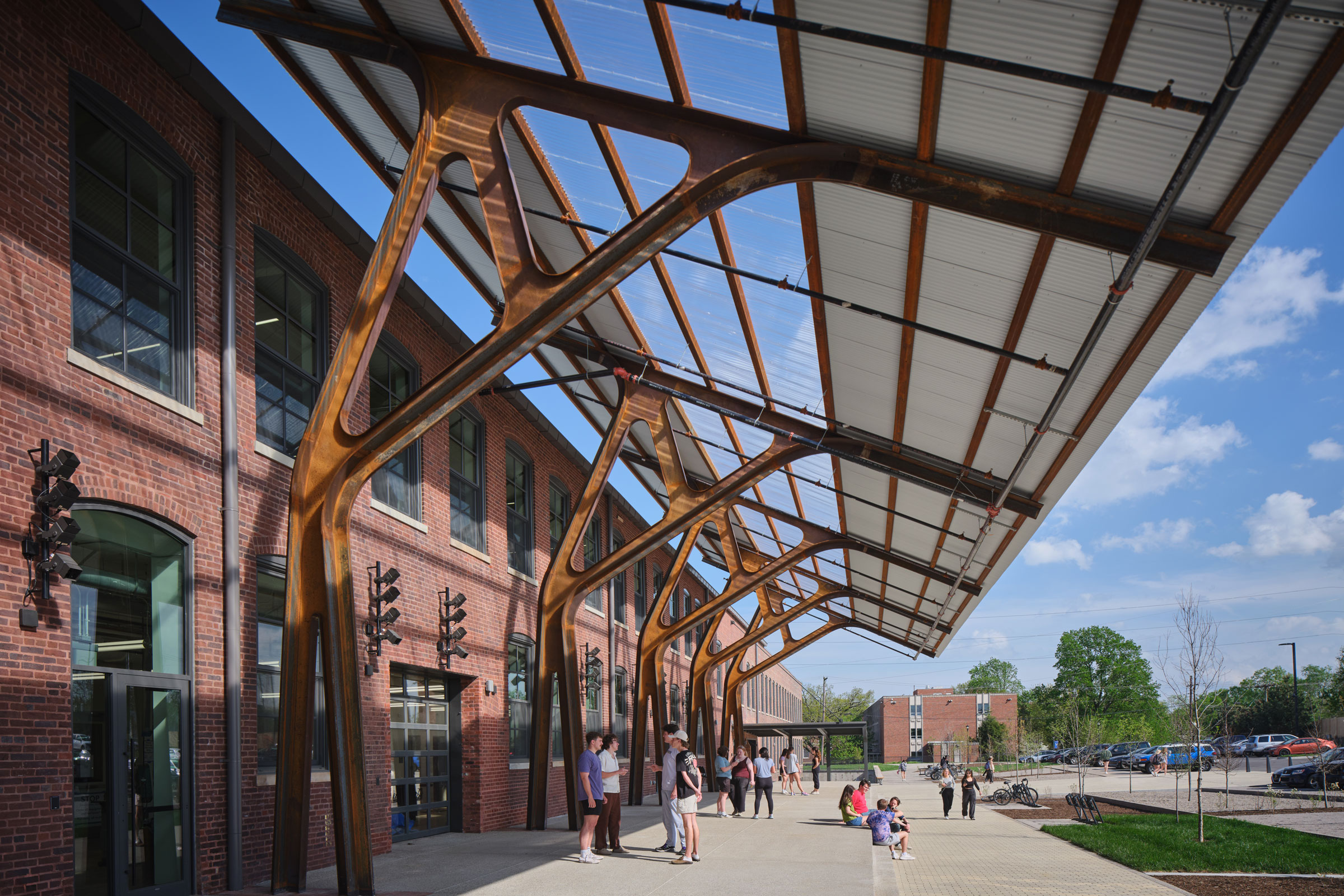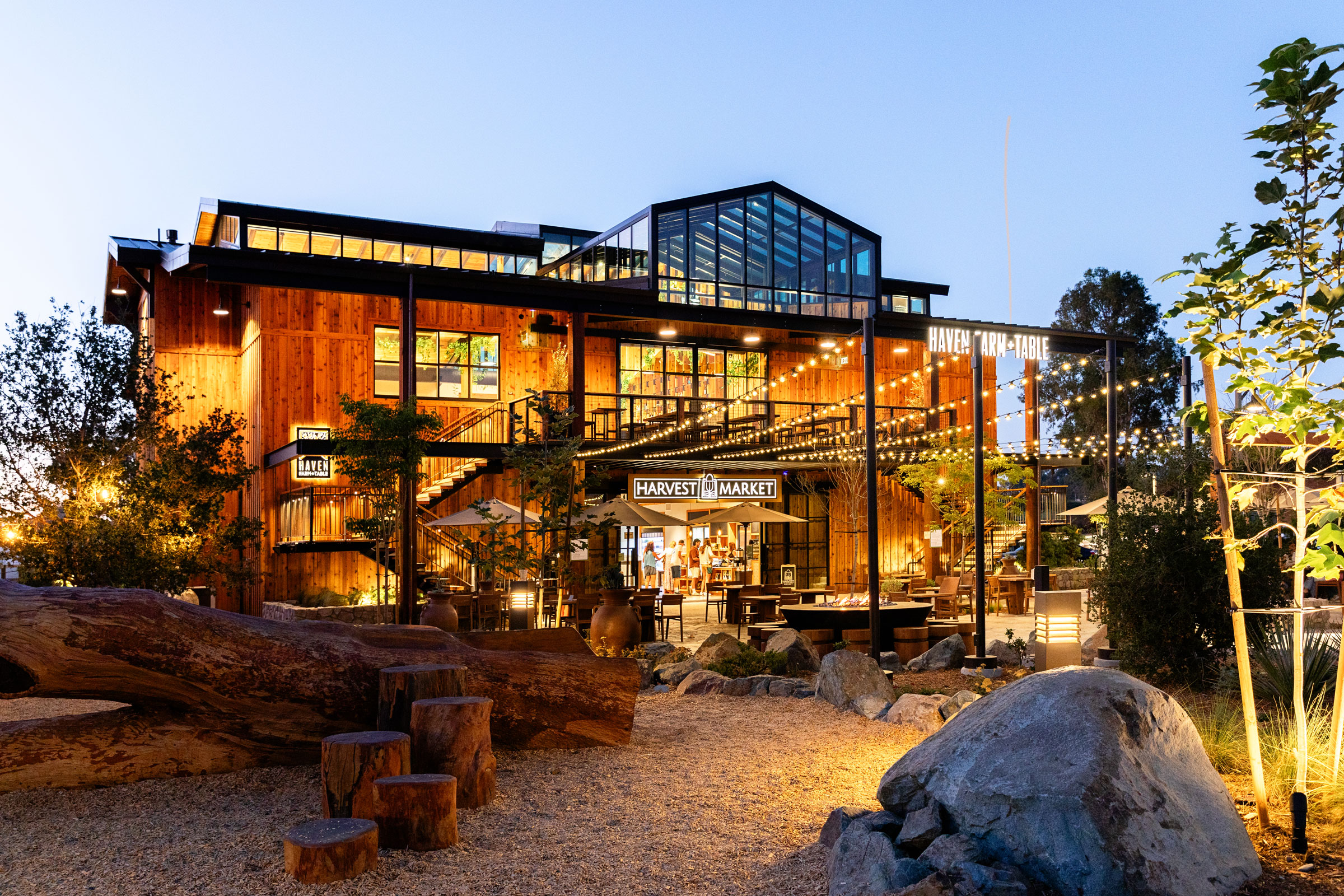Story at a glance:
- Architects and designers are increasingly turning to a large list of sustainable building materials for projects.
- Sustainable building materials typically have low embodied carbon or incorporate recycled waste products.
- Bamboo, mass timber, adobe brick, stone, reclaimed wood, and low-carbon concrete alternatives are some of the most popular sustainable building materials.
The construction and use of built structures produces roughly 40% of the world’s carbon emissions, according to a 2019 report from the International Energy Agency. The construction industry as a whole is responsible for producing 25% of the world’s solid waste and extracting more than 30% of the planet’s natural resources. This is largely due to the types of building materials traditionally used in modern architecture—many of which require significant energy to harvest, prepare, and manufacture.
These figures can be mitigated by the widespread adoption of sustainable building products. Here are 25 of the most promising sustainable building materials in 2024.
What Makes a Material Sustainable?
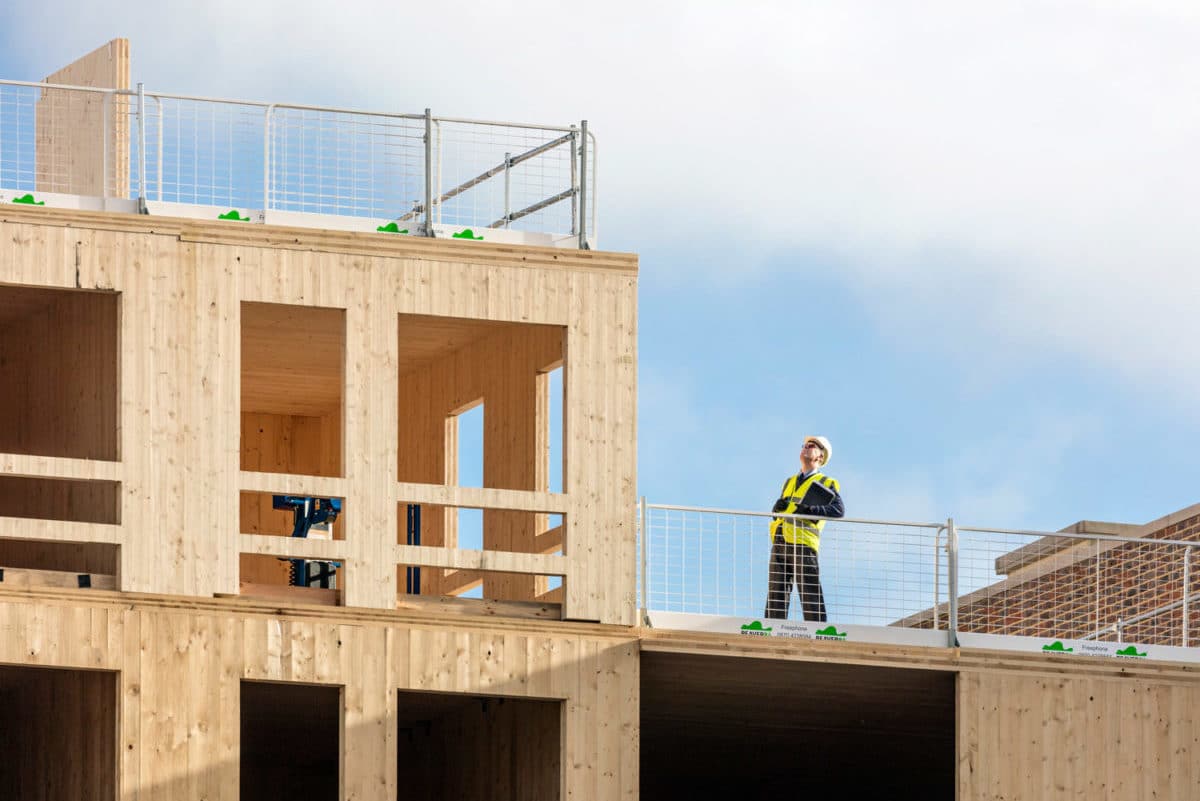
Sustainable building materials like cross laminated timber help architects create greener buildings. Photo by Daniel Shearing
Before we explore the different types of sustainable materials, let’s take a moment to discuss what makes a material sustainable, especially considering that “sustainability” has become a bit of a buzzword.
In the realm of green architecture, construction, and design, sustainable materials are considered to be those materials whose collection, refinement, production, and long-term use has minimal negative impact on the environment. Most sustainable materials are derived from—or are wholly—natural, renewable resources like stone, bamboo, adobe, and the like, but the category can also include recycled materials like plastic.
25 Types of Sustainable Materials
1. Mass Timber
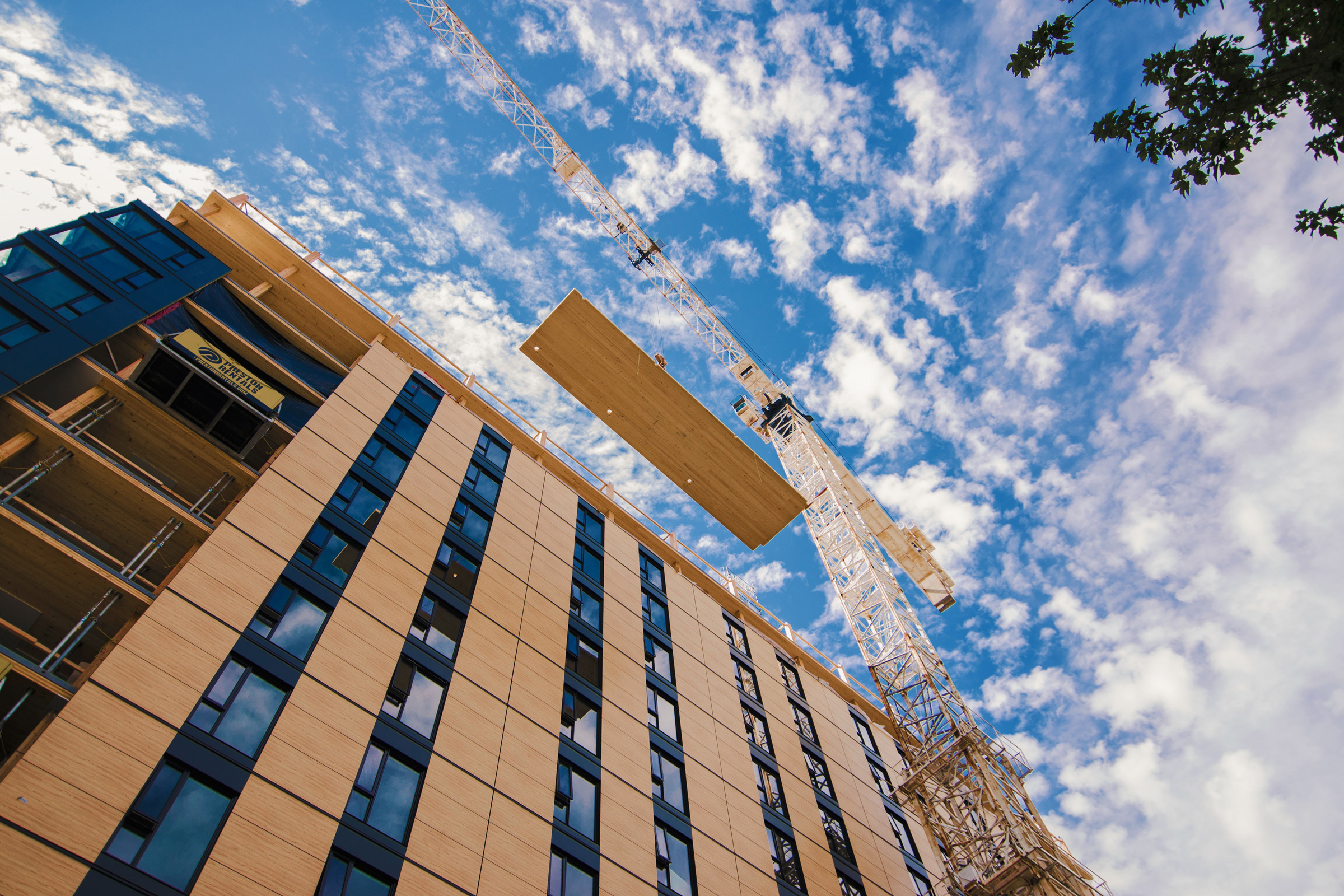
The Brock Commons Tallwood House is constructed primarily from CLT and is one of the tallest mass timber buildings in the world. Photo by Pollux Chung
Mass timber refers to a subset of engineered wood made by binding together multiple layers of wood planks. The resulting product is much stronger and more structurally sound than traditional timber, which allows it to be used as a viable, low-carbon alternative to concrete.
There are four main categories of mass timber: cross-laminated, nail-laminated, dowel-laminated, and glued-laminated.
- Cross-laminated timber (CLT). Several layers (typically an odd number) of wood planks are glued together, with each layer perpendicular to the one above and below it.
- Nail-laminated timber (NLT). One of the oldest forms of mass timber; layers of wood are bound together by nails.
- Dowel-laminated timber (DLT). Wood planks are drilled and then bound together by long wooden dowels.
- Glued-laminated timber (Glulam). Layers of wooden planks are attached to one another using glue.
These mass timber products offer increased compression strength and flexibility compared to traditional raw timber. As a result, they can be used to construct load-bearing features such as structural panels, beams, and posts, opening up a whole new world of possibilities for large-scale timber construction.
Because mass timber products are pre-cut and pre-manufactured in an offsite factory they offer a high level of quality control and therefore produce less waste during construction. “With normal construction you have tons of waste,” Paulo Martins, principal of Paulo Martins Arquitectura & Design—the firm that designed one of Portugal’s first mass timber homes—previously told gb&d. “It’s a much cleaner way of making houses. It uses less space because as the wood arrives at the building you mount it immediately. You don’t have to store the materials. You can reduce the number of trucks going out and coming in [and their] carbon emissions.”
Pros of Mass Timber
- Carbon sequestration. Mass timber absorbs carbon during its growth period and sequesters it throughout its operational lifespan, greatly reducing a structure’s overall embodied carbon.
- Fast construction. Because mass timber is manufactured offsite, arrives pre-cut, and is lighter than other structural building materials, onsite construction of mass timber buildings is much faster than it is for concrete or steel buildings, only requiring about three-quarters of the time.
- Durable and strong. Mass timber has a strength-to-weight ratio that is comparable to steel or concrete and performs well during seismic activity; properly constructed and maintained mass timber structures have an estimated lifespan of 50 to 100 years.
Cons of Mass Timber
- Susceptible to water damage. Like any wood product mass timber is susceptible to water damage in the event of prolonged exposure to moisture or high humidity levels; this can lead to rot, warping, and a reduction in structural integrity.
- Higher upfront costs. From a per-unit standpoint mass timber is more expensive than steel or concrete and has as much as a 26% higher front-end cost; these higher upfront costs, however, are partially balanced out by the reduced labor needs, faster construction times, and higher end-of-life salvage value associated with mass timber construction.
2. Terrazzo
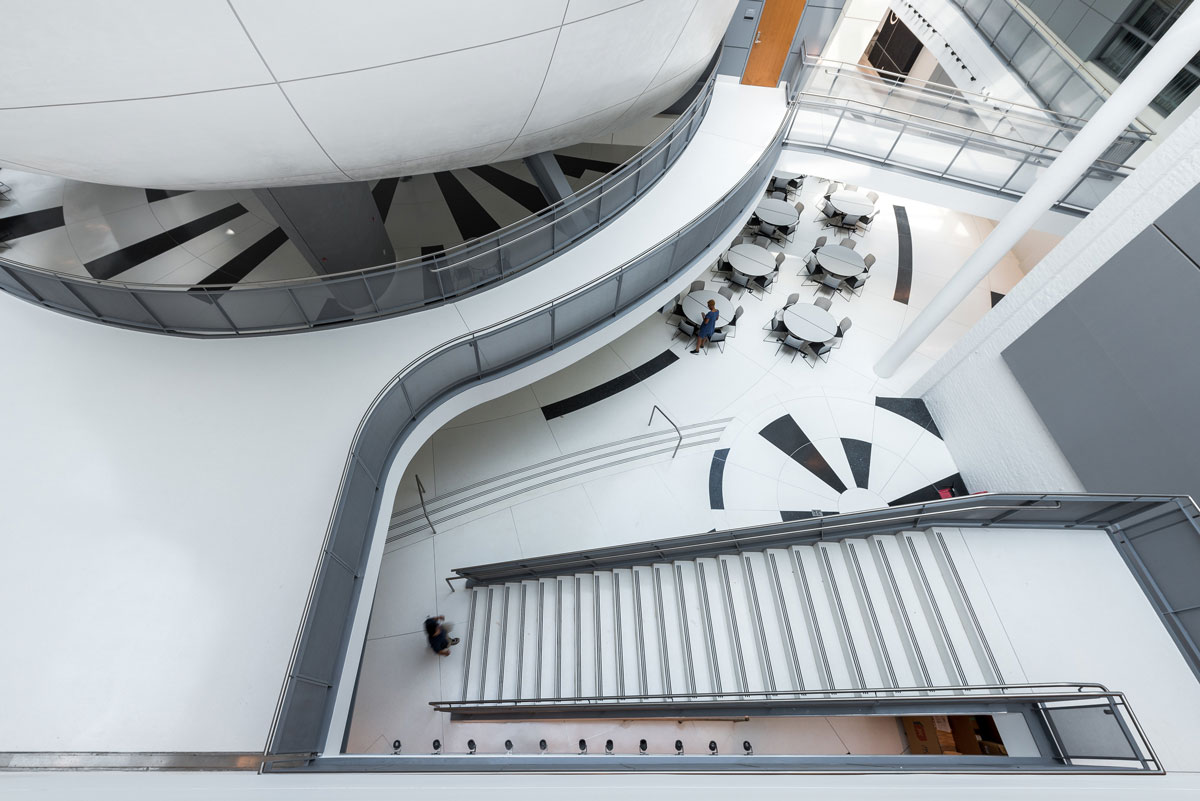
The Duke Ellington School of the Arts in DC features poured-in-place epoxy terrazzo. Photo courtesy of Terrazzo & Marble Supply Companies
First invented in the late 1500s, terrazzo is a type of composite wall and flooring treatment traditionally consisting of chipped marble, granite, and/or quartz that is then cast in a cementitious binder, with most modern terrazzo cast in epoxy resin.
Terrazzo flooring became more common in the 20th century after Italian quarrymen began casting leftover marble and granite chips in cement to pave their terraces. It is this reuse of stone refuse—an already sustainable material—that would otherwise go to waste that makes terrazzo an eco-friendly building material.
Even today most terrazzo suppliers—including Terrazzo & Marble Supply Companies—uphold the tradition of sourcing their aggregate material from local quarries, which also helps to reduce carbon emissions incurred as a result of the shipping process.
“We take a lot of things that would be put into the waste stream that we can reclaim and reuse in a terrazzo floor,” James Bateman, terrazzo division manager of Terrazzo & Marble Supply Companies, previously told gb&d.
Pros of Terrazzo
- Easy to clean. After installation terrazzo requires very little upkeep and is extremely easy to clean; periodic sweeping/vacuuming and mopping using soap and water is enough to prevent dirt and grime from accumulating.
- Customizable. Because terrazzo is a mixed-composite material, there are a wide variety of colors, designs, and aggregates to choose from, making it extremely customizable; marble and granite are the most popular choices but terrazzo can also accommodate everything from quartz, silica, glass, metal chips, and even shells.
- Long-lasting. Like stone, terrazzo possesses incredible durability and lasts for a very long time; once installed, terrazzo can go between 40 and 100 years before needing to be replaced, with most lasting upwards of 75 years.
Cons of Terrazzo
- Can be expensive. One of the main downsides of terrazzo is its upfront cost, which can drastically increase a project’s overall construction price; on average, a single square foot of terrazzo typically costs $22 for both the materials and installation, but prices can range as high as $90 per square.
- Can be difficult to install. The installation process for terrazzo is incredibly precise and generally requires hiring experienced professionals; improperly installed terrazzo can lead to visual defects and compromised structural integrity.
3. Structural Insulated Panels
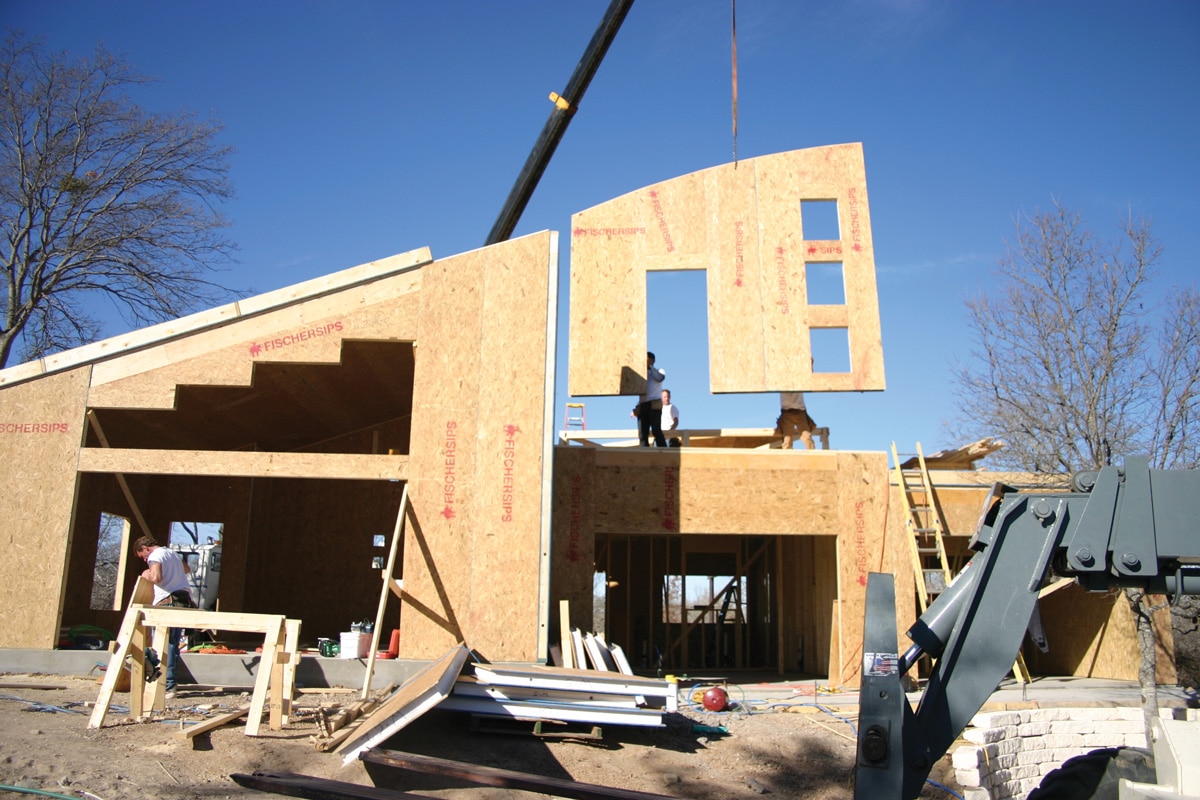
SIPs are a type of high-performance composite paneling that is used to create energy-efficient walls, floors, roofs, and foundations for residential and light construction projects. Photo courtesy of FischerSIPS
Structural insulated panels (SIPs) are a type of prefabricated, high-performance composite paneling used in residential and light construction projects to create walls, floors, roofs, and even foundation systems. SIPs consist of an insulated core sandwiched between two sheathing panels and are typically fastened with screws to a structural frame. SIPs are extremely strong and share the same structural properties as traditional I-beams, with the insulated core acting as the web and the sheathing fulfilling the function of the flanges.
Most SIPs use oriented strand board (OSB) for their sheathing and feature a polyurethane insulated foam core, though natural fiber insulation or plant-based polyurethane rigid foam may also be used to maximize sustainability. OSB is already considered to be a sustainable material, as it sequesters carbon and is typically produced from new growth rather than old growth trees.
One of the main benefits of using SIPs in construction is that they improve a structure’s overall energy efficiency, reducing heating and cooling energy loads by at least 50% when compared to traditional timber-framed structures. This is largely because SIPs are prefabricated in highly. controlled environments that greatly reduce the possibility for air leakage and thermal bridging. “Because SIPs are more airtight than your typical structure, you don’t have a lot of air passing in and out of your house,” Damien Pataluna, owner of FischerSIPS, previously told gb&d.
Pros of SIPs
- Faster construction. Because they are prefabricated ahead of time and then shipped to the job site, SIPs help reduce both construction times and on-site labor requirements; a study conducted by the RS Means unit of Reed Construction found that SIPs reduce on-site construction times by as much as 55%.
- Strong and durable. SIPs are designed to shoulder in-plane compressive loads of roughly two tons and are capable of bearing the lateral loads caused by high winds and earthquakes; buildings constructed from SIPs are, on average, two-and-a-half times stronger than traditional sick-framed structures.
- Improved indoor air quality. The airtight construction of SIPs helps reduce air leakage and ensures that indoor air circulation only occurs through controlled ventilation systems that filter out pollutants, greatly improving indoor air quality.
Cons of SIPs
- Higher upfront costs. While building with SIPs is one of the cheapest options for constructing high-performance, energy-efficient structures, SIPs still cost 3 to 7% more than traditional stick-framed buildings.
- Difficult to modify onsite. Because SIPs are prefabricated entirely off-site and then shipped to the job site as a finished product, they are more difficult to modify onsite should any corrections or adjustments need to be made.
4. Recycled Rubber
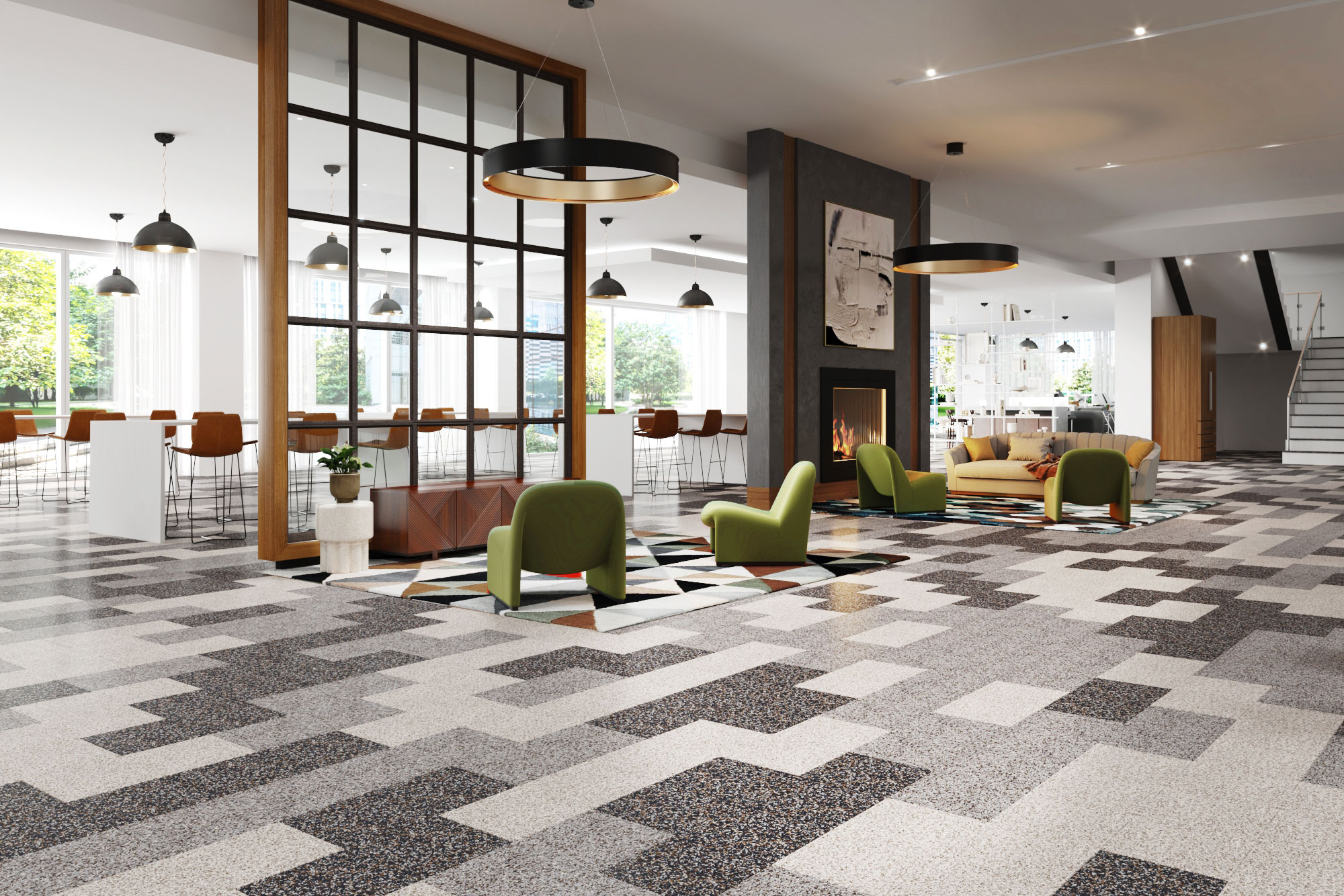
Regupol uses more than 115 million pounds of recycled rubber—or approximately 9 million reclaimed tires—each year to manufacture a wide range of flooring products. Photo courtesy of Regupol
Natural rubber is derived from plant matter and eventually decomposes over time, making it a more environmentally friendly option than, say, plastic. Historically, however, the harvesting and production of rubber—particularly for use in tires—has contributed to deforestation and pollution.
Fortunately rubber can be recycled and reused once it’s reached the end of its operational life cycle. One of the most common uses for recycled rubber in the built environment is flooring, as the natural elasticity of rubber makes it ideal for absorbing impacts, resisting damage, and makes for a more comfortable surface to stand or walk on for long periods of time.
REGUPOL, for example, is one of the leading manufacturers of rubber flooring products and an industry innovator in the reuse of post-consumer tires. “The company’s products use 93% to 96% post-consumer waste, diverting that from landfills to recycle 99M tons of elastomers per year and helping to support the ecological health of our planet and the water table,” Wil Younger, marketing manager for REGUPOL, previously wrote for gb&dPRO.
Pros of Recycled Rubber
- Durable. Rubber flooring has a naturally high tensile strength thanks to its chemical composition, which makes it extremely durable and resistant to tearing or excess wear from exposure to the elements.
- Noise reduction. Rubber acts as a natural acoustic dampener and can help reduce noise transmission between floors or walls; when paired with rubber wall panels and/or rubber ceiling treatments, rubber floors significantly aid in sound control, making them ideal for use in gyms and schools.
- Shock absorption. Rubber’s elastic and viscous properties also make it an excellent shock absorber, one that is capable of withstanding heavy impacts and vibrations without sustaining damage; this makes rubber ideal for use as flooring and provides improved seismic resistance.
Cons of Recycled Rubber
- Potential higher upfront cost. Recycled rubber products, especially flooring, can be more expensive than other products in the same class, with poured rubber flooring being one of the most expensive options; these higher upfront costs are, however, typically justified by the high durability and long lifespan recycled rubber products offer.
- Can be difficult to install. When used as flooring, recycled rubber rolls, mats, and panels can be cumbersome to handle; installing rubber flooring can be somewhat time-consuming, as the rubber must first acclimate to the ambient temperature and requires dry-fitting before it can be properly installed.
5. Stone
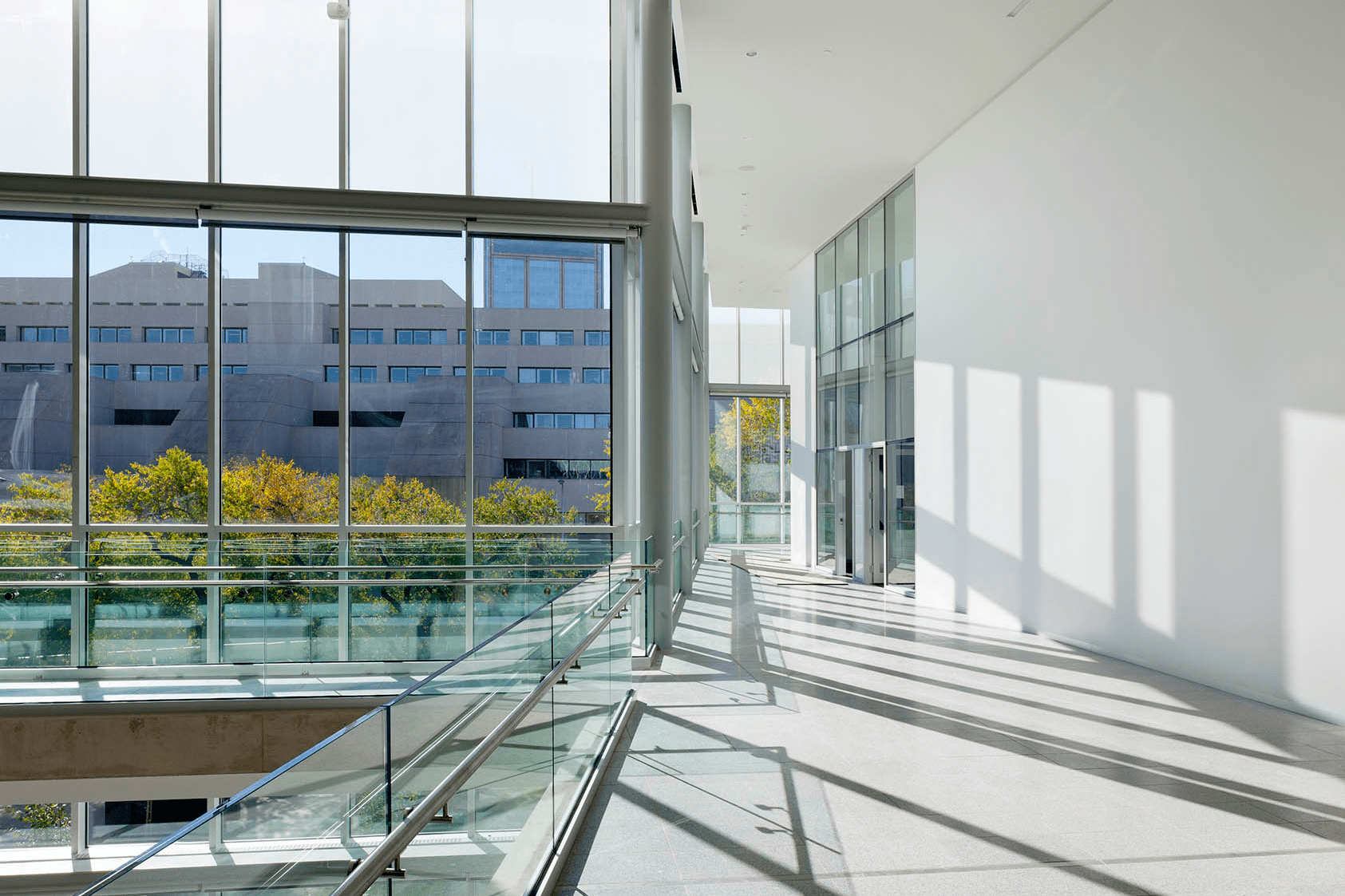
The Royal Alberta Museum in Edmonton received a Tucker Design Award from the Natural Stone Institute in August 2020. Designed by architecture firm DIALOG, this project used Polycor’s Indiana limestone in standard gray. Photo courtesy of Polycor
Stone is one of the oldest building materials known to man. Readily available and constantly being produced by the earth, stone has a naturally low embodied energy, an extremely long life cycle, and releases no volatile organic compounds into the air, making it one of the most sustainable materials there is—especially if sourced locally.
Thanks to the sheer variety of stone types (e.g. granite, sandstone, marble, basalt, gneiss, quartz) and the wide assortment of stone products—raw stone, cut stone, stone slabs, stone panels, etc.—stone has a nigh-unparalleled range of construction uses and is extremely versatile.
Polycor, one of leading producers of high-quality stone in North America, has supplied stone for everything from floors and countertops to wall cladding and columns.
Pros of Stone
- Extremely durable. Stone is an incredibly strong material and many types of stone have high load-bearing capabilities; stone is also quite resilient and is able to withstand the elements with ease.
- Low maintenance. Once installed, stone products typically require very little maintenance—in most cases, periodic cleaning with soap and water and occasional grout/mortar touch-ups are all that’s required.
- Versatility. As previously hinted at, the sheer variety of stone types and stone products makes stone an incredibly versatile material, one that can compliment a variety of architectural styles and functions.
Cons of Stone
- Can be expensive. Compared to many other natural building materials, stone can be extremely costly, especially if your project requires a high-quality stone like marble or certain granites.
- Heavy. Similar to something like precast concrete, stone is an incredibly heavy material, which makes it difficult to transport and install—this can also have the unintended consequence of increasing construction time and emissions.
- Requires skilled workers. When it comes to stonemasonry, there is little room for error, as stone can be very difficult to move or alter once set in place; as a result, stone always requires skilled, experienced workers.
6. Reclaimed Wood
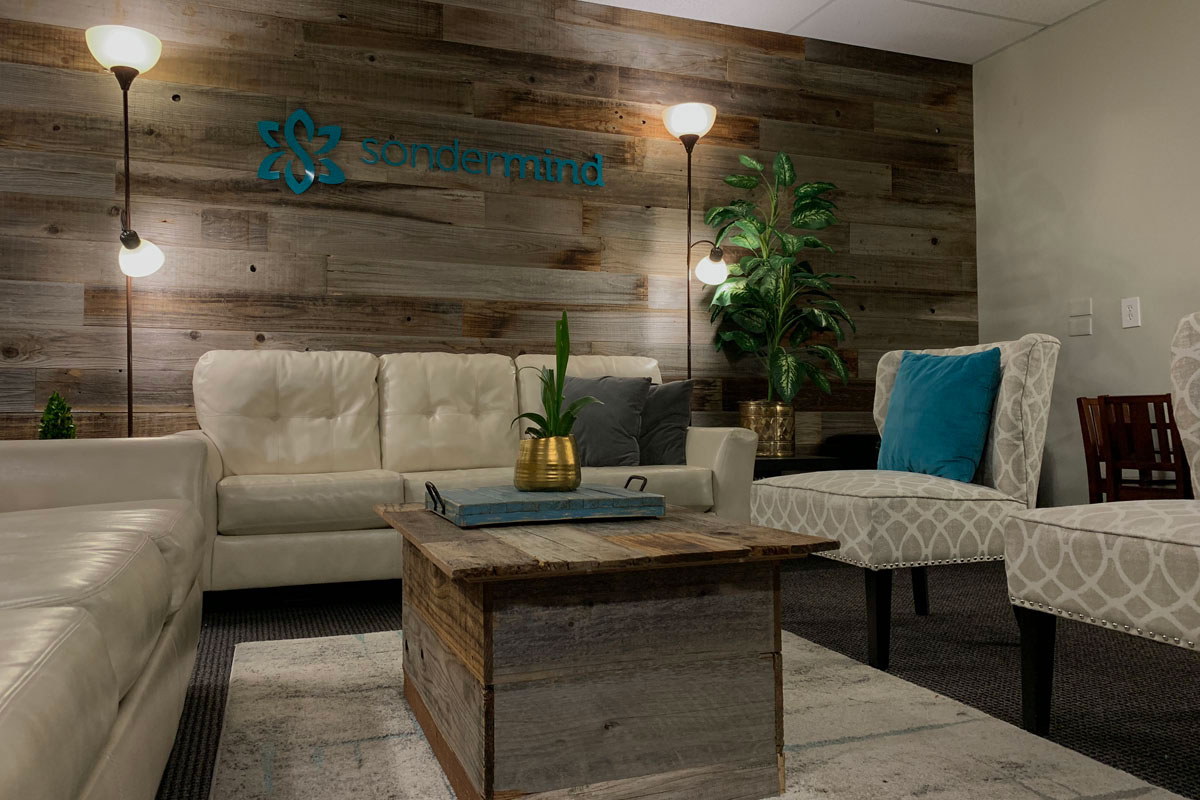
Indoor reclaimed wood accent wall and table by Woodstock Architectural Products. Photo courtesy of Woodstock Architectural Products
Wood is another building material that has been used for millennia—and while timber is technically a renewable resource, it can take a long time to regrow, especially if harvested unethically. That’s why utilizing reclaimed wood in new construction projects has become common practice.
“Reclaimed wood reduces the demand for harvesting new timber and minimizes deforestation. Proper forest stewardship is essential to ensure trees grow for years to come,” Kevin Fults, an expert in the wood industry, previously wrote for gb&d. In most cases reclaimed wood can be used exactly as you’d use new wood, giving it a variety of applications, such as: building frameworks, flooring, furniture, walls, rafters, fences, etc.
If the reclaimed wood you’re using in your project has been certified by the Forest Stewardship Council, it can go toward earning LEED points.
Pros of Reclaimed Wood
- Reduces waste. Wood accounts for roughly 8.3% of all landfill waste, according to the EPA, despite the fact that much of it is still viable for construction purposes. Incorporating reclaimed wood into a project helps minimize waste and extends the wood’s operational lifespan.
- Aesthetically pleasing. The weathered, aged look of reclaimed wood also gives construction projects a character you might not get from fresh timber.
- Natural insulator. Regardless of whether it’s new or reclaimed, wood is a natural insulator with a low thermal conductivity, which means it will help keep interiors warm even in cold climates, thereby reducing a structure’s electric heating loads.
Cons of Reclaimed Wood
- Can be expensive. If you aren’t collecting recycled wood yourself, sourcing it from a company can be expensive—sometimes even more expensive than buying new wood—as reclaimed wood must be processed and inspected before it is ready for reuse.
- May contain chemicals. If the history of your reclaimed wood is unknown, it’s possible that it may contain unwanted chemicals that could damage occupant health in the long-term.
- Susceptible to pests. Similarly, reclaimed wood can contain hidden pests like termites and woodlice that can compromise its structural integrity—and even if it hasn’t been damaged by insects, reclaimed wood is still susceptible to future attacks.
7. Adobe Brick
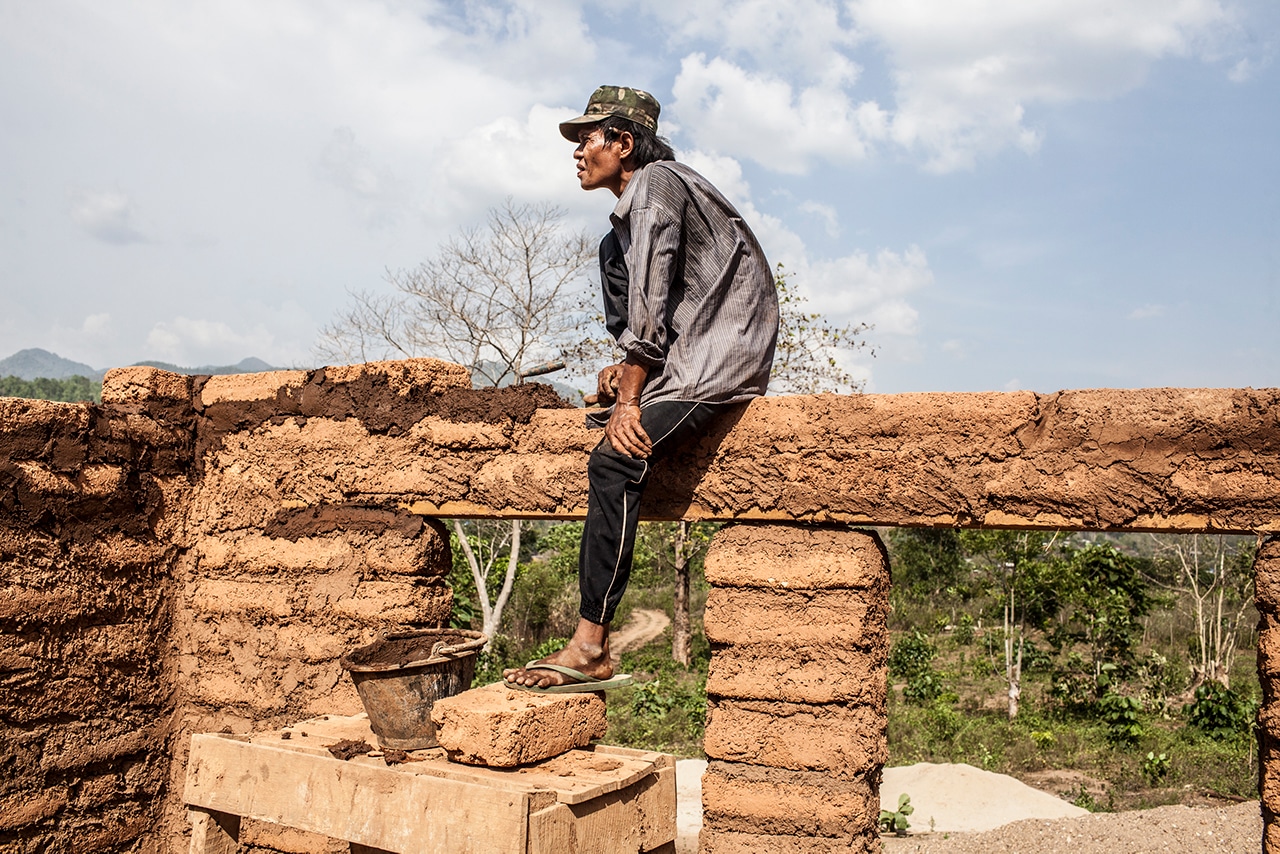
Construction of an adobe brick building by the organization Gyaw Gyaw on the Thailand-Burma border. Photo courtesy of Jonathan González.
Like stone and timber, adobe brick is another sustainable building material that has been used for centuries, particularly in the American southwest, Central America, and South America. As a composite material, traditional adobe is composed primarily of sand, clay, and silt that has been mixed with water and some organic material like dung or straw that acts as a binding agent.
This mixture is then pressed into a wooden frame to create bricks. Once dried, adobe bricks are exceptionally strong and may be stacked like conventional bricks to construct load-bearing walls or laid out in rows to form flat surfaces like roofs.
After adobe bricks have been put in place, they are covered with plaster, stucco, or whitewash to protect them from the elements. Because adobe bricks are produced using local, non-toxic materials, produce little-to-no carbon emissions, and last for a long time, they are considered to be extremely sustainable.
Pros of Adobe Brick
- Energy-efficient. Adobe brick has a high thermal mass and low thermal conductivity, making it extremely effective at regulating indoor temperatures without the need for heating and air conditioning; as a result, adobe brick buildings are considered to be energy-efficient.
- Durable. Like most earthen materials, adobe brick is extremely durable and boasts a high compressive strength; when properly maintained, adobe bricks can last for thousands of years.
- Fire-resistant. Because adobe bricks are composed primarily of earthen materials, they are naturally fire-resistant, capable of withstanding wildfires with minimal damage.
Cons of Adobe Brick
- Heavy. Due to their composition, adobe bricks are quite heavy. This can slow down construction and typically necessitates the installation of concrete foundation or footings, which can add to a structure’s overall carbon footprint.
- Not suitable for all climates. Generally speaking, adobe brick is best suited to very warm regions that receive little rainfall, as regular exposure to water or freezing temperatures can lead to accelerated deterioration.
- High-maintenance. In order for adobe bricks to retain their structural integrity, they must be inspected regularly so any signs of damage (holes, cracks, etc.) can be addressed immediately; adobe bricks also require you reapply their coating every few years.
8. Earth Bags
For the most part, earth bags are exactly what they sound like: bags that have been filled with earth. If you want to get more specific, earth bags typically feature a plastic bag or sack that is then filled with a mixture of local soil. This mixture generally contains moist subsoil with a sufficient clay content, as clay helps the sediment remain cohesive—in some cases, crushed volcanic rock or gravel may be used.
For construction purposes earth bags are laid out and stacked in staggered courses, similar to how brick walls are built. They are capable of supporting straight or curved walls and, in the case of the latter, often feature domed roofs. Once earth bag walls have been erected, they are finished with a plaster; this helps them better withstand the elements.
From a sustainability standpoint earth bags are extremely environmentally friendly, as they require very little energy to produce, last a very long time, and can be recycled once they reach the end of their life-cycle.
Pros of Earth Bags
- Inexpensive. Earth bags typically make use of locally sourced sediment, so they are extremely cost-effective; this makes earth-bag construction a viable building strategy even in impoverished and low-income areas.
- Durable. As long as earth bags are properly installed and maintained, they are capable of withstanding everything from severe weather to earthquakes with ease; in terms of their actual lifespan, earth-bag buildings can stand for hundreds of years.
- Low-emission. Earth-bag construction requires very little energy expenditure compared to other construction methods, resulting in fewer carbon emissions
Cons of Earth Bags
- Labor-intensive. When it comes to both their production and construction, earth bags require a lot of manpower, as they necessitate the collection, transportation, and placement of hundreds (if not thousands) of pounds of sediment.
- Limited construction use. While earth bags have a variety of uses in small-scale construction projects, they are significantly less feasible for larger, more-involved building projects.
- Aren’t suitable for all climates. Earth-bag structures can handle a lot of abuse, but they don’t fare well in extremely wet climates, as prolonged dampness can cause the bags to expand and contract, resulting in structural deterioration.
9. Bamboo
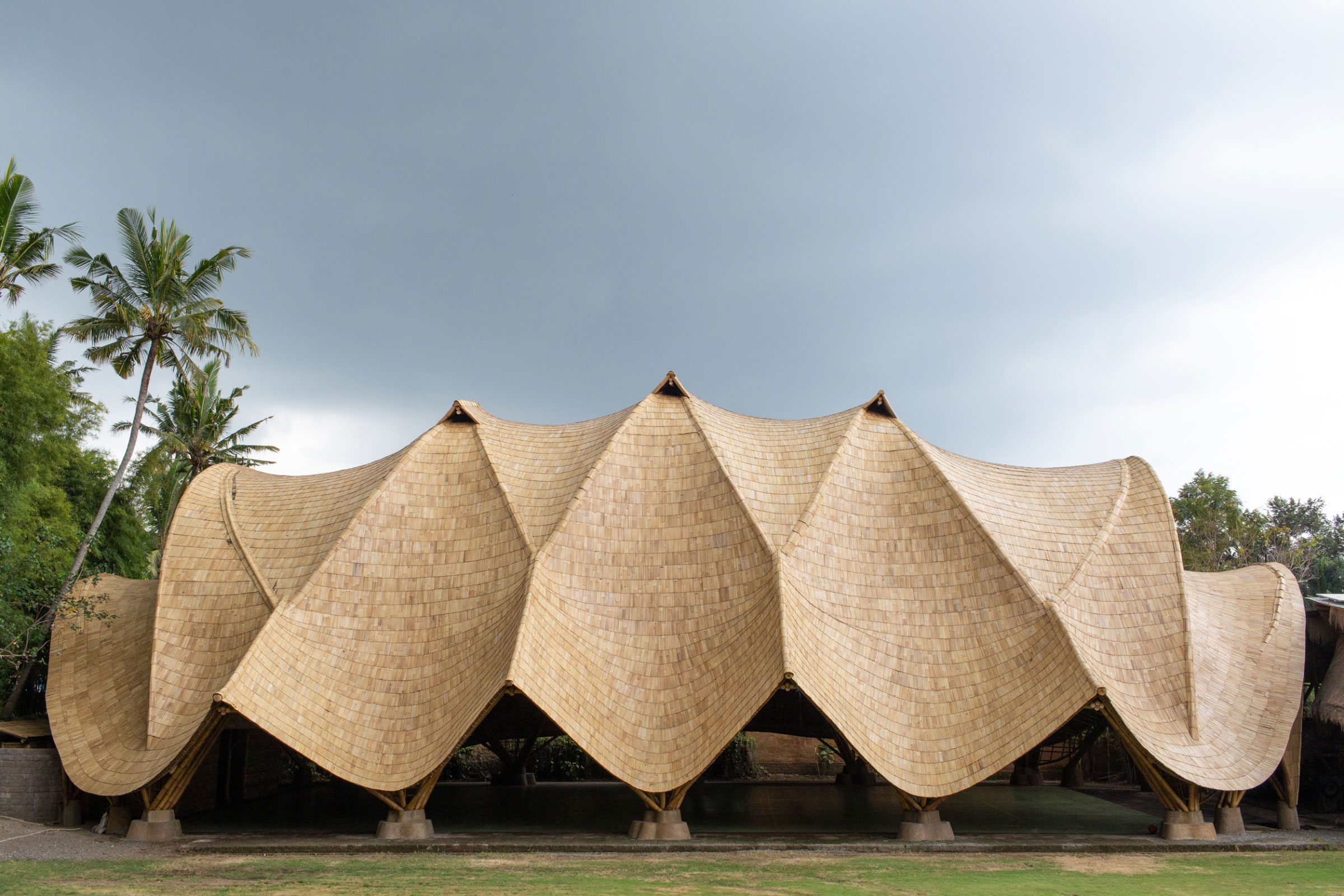
The Green School in Bali, sometimes referred to as the bamboo school, is a private, international school that teaches pre-K through high school. The campus highlights the natural environment and teaches sustainable practices. Photo by Tommaso Riva
Over the last few years bamboo has seen an explosion in popularity—a phenomena largely attributable to bamboo’s contemporary aesthetic and extremely fast growth rate. Unlike most hardwoods, which typically require twenty years between planting and harvesting, bamboo can be harvested every five to seven years. Bamboo also absorbs twice the amount of carbon, requires less water, and doesn’t need fertilizer to grow.
Traditional bamboo construction produces very little waste and utilizes the whole bamboo pole, split poles, and finely-worked bamboo slats to build everything from bridges and huts to the structural support systems of buildings. The Arc, designed by IBUKU for the Green School in Bali is a testament to how bamboo can be used to build the majority of a structure.
Bamboo can also be formed into planks using one of two methods: cutting poles into thin strips, drying them, gluing them together, and laminating the finished project or by shredding bamboo culms down into fibrous strands and weaving them back together to create stranded bamboo planks.
Laminated bamboo has a variety of construction uses ranging from fences and flooring to furniture and interior decorations. Due to its improved strength and durability, stranded bamboo is used almost exclusively for flooring.
Pros of Bamboo
- High strength-to-weight ratio. While it may not be as strong as steel, bamboo nevertheless has a high strength-to-weight ratio, which means it can safely support a range of complex structures.
- Joint mobility. Compared to most other building materials, bamboo joints have a higher range of mobility—this quality, along with its lightness, makes bamboo a great building material for earthquake-prone regions.
- Biodegradable. Once the construction life-cycle of bamboo is complete, it can be left to biodegrade and may be used for composting purposes in as little as six months.
Cons of Bamboo
- Moisture damage. Bamboo is only durable when it’s dry—if regularly exposed to water, it can develop fungal rot and deteriorate in just a year’s time.
- Attracts pests. Like hardwood, untreated bamboo is susceptible to attacks from termites and beetles, which can reduce bamboo’s lifespan by a significant margin; in order to deter pests, bamboo must be treated with boron.
- Shipping distance. Because bamboo doesn’t grow as well outside of Asia and South America, it must be shipped long distances, which can result in increased carbon emissions.
10. Cork
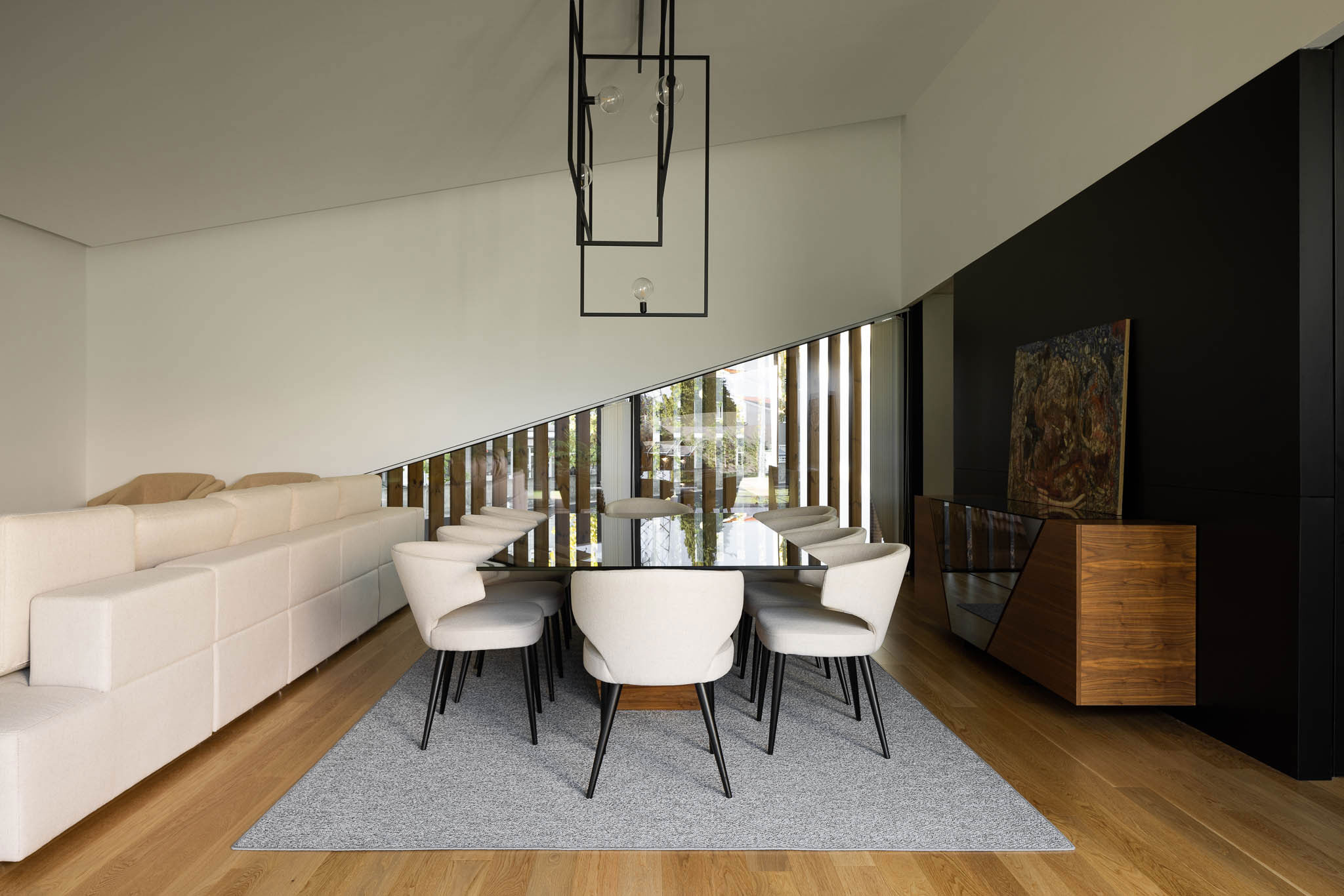
Lustrous flooring made largely of cork creates a cozy feeling. The cork is not only a more sustainable option; it is a natural sound insulator. Photo by Ivo Tavares Studio
Unlike timber, bamboo, or even hemp products, cork products do not require that the entire plant be harvested—rather, the bark is all that’s collected and doing so doesn’t harm the tree itself. This means that a single cork oak tree can be harvested multiple times throughout its natural lifespan, typically at intervals of once every nine years.
After it is harvested, cork is shredded, compressed into sheets, and baked in a kiln—the finished product is then cut into planks, tiles, or left as a sheet, at which point it can be used for construction purposes, typically as either flooring or insulation.
Once cork products reach the end of their construction-use cycle, they can be composted back into the earth.
Pros of Cork
- High insulating capacity. The cells of cork bark contain small pockets of air that effectively prevent heat from getting through, making it an excellent insulator.
- Antimicrobial. Because it contains phenolic compounds, cork is naturally antimicrobial and is highly resistant to fungus, mold, and mildew growth.
- Fire resistant. In its natural state, cork is extremely fire-resistant; it will burn, but it does so very slowly and without a flame, which reduces the pace at which fire spreads.
Cons of Cork
- Susceptible to UV damage. When used as flooring cork has a tendency to yellow and fade over time if regularly exposed to sunlight.
- Can be expensive. Generally speaking cork is more expensive than, say, laminate flooring, largely due to the higher level of skill required to harvest cork without killing the tree, as well as the fact that cork is only harvested once a year.
- Highly responsive to humidity. Unlike hardwood, cork expands in all directions when exposed to high humidity, which means it requires more room for movement; when humidity is low, it can cause gaps to appear in cork flooring, especially if it isn’t glued down.
11. Hempcrete
An alternative to concrete hempcrete is a composite material formed by mixing hemp hurds with lime, pozzolans, or sand. As is the case with any crop, hemp absorbs carbon while it grows and continues to store carbon after it has been processed into hempcrete, thereby reducing its overall carbon footprint and making it much more environmentally-friendly than conventional concrete.
Hempcrete’s high thermal mass and lightweight nature makes it great as an insulator or to form non-load-bearing infill walls. It can also be applied to existing walls as a plaster.
Pros of Hempcrete
- Renewable. Hemp is a renewable material with a very rapid growth cycle. Once planted, hemp stalks can be harvested in just three to four months, making it more sustainable than hardwood, softwood, and even bamboo.
- Mold-resistant. Thanks to the inclusion of lime in the initial production process, hempcrete is both antimicrobial and antifungal, making it resistant to mold and mildew, which helps to improve indoor air quality.
- Moisture control. Hempcrete is capable of absorbing extreme amounts of moisture without jeopardizing its structural integrity or insulative properties, making it an excellent choice in areas with high humidity.
Cons of Hempcrete
- Long drying time. Once cast hempcrete typically requires between 6 and 8 weeks before it fully dries and can hold a proper finish, thereby extending the overall construction time by a considerable margin.
- Low compressive strength. Unlike traditional concrete hempcrete has a fairly low compressive strength, which means it cannot be used to construct load-bearing walls.
- Learning curve/limited experts. Because hempcrete is a fairly recent invention, it isn’t particularly well-known within most construction spheres—as a result, it can be hard to find a company or contractor with the experience necessary to build with hempcrete.
12. Timbercrete
Similar to hempcrete Timbercrete is another alternative to traditional concrete and is formed by combining sawdust and small wood chips with water, concrete, and binding agents. It is lighter and produces fewer carbon emissions than concrete, while also offering improved insulative properties.
In its current form Timbercrete is best suited for use in exterior walls that prioritize insulation over load-bearing capacity, though it can also be used in roofing due to it being lighter than concrete.
Similar to concrete Timbercrete can be molded on-site or precast ahead of time and shipped to the project site.
Pros of Timbercrete
- Ready availability. Due to the fact that both concrete and sawdust/wood chips are readily available in most places, Timbercrete can be sourced locally, thus reducing construction time, costs, and emissions.
- High thermal capacity. Timbercrete is capable of absorbing and storing thermal heat during the day and releasing it slowly throughout the night; this helps improve a structure’s overall energy efficiency.
- Traps carbon. Unlike conventional concrete and many other traditional building materials, Timbercrete traps carbon and keeps it from entering the atmosphere.
Cons of Timbercrete
- Low load-bearing capacity. Compared to concrete Timbercrete has a much lower load-bearing capacity, which means it can’t be used for structural support.
- Requires precise mixing. In order for Timbercrete to be structurally sound it needs to be mixed correctly. Considering Timbercrete is a relatively new material, there aren’t many guides detailing the precise mixing process.
- Limited uses. Because it’s weaker than concrete, timbercrete has fewer practical uses and is mainly confined to non-structural walls, fences, and small exterior structures.
13. Sheep’s Wool

Crafted from a blend of wool and flax, the new Craggan Flax fabric retains the raw appeal of its natural composition while maintaining its contemporary aesthetic of a chunky weave. Photo courtesy of Camira
Unlike most of the other materials on this list, wool isn’t prized for its durability, strength, or versatility, but for its insulative qualities. As a natural insulator, wool is an excellent alternative to conventional fiberglass insulation; it doesn’t contain any dangerous substances, effectively regulates temperature, is flame-resistant, and helps remove toxins from the air.
Wool has also been used as a sustainable alternative to synthetic-fiber carpets, as it requires less electricity to manufacture and doesn’t include any harmful chemicals. In recent years, companies like Camira have even started using wool—in conjunction with other natural materials—to produce furniture fabric.
Pros of Sheep’s Wool
- Absorbs sound. Wool is a natural sound absorber and is capable of reducing noise by as much as 50%, allowing for a much quieter and comfortable indoor environment.
- Fire-resistant. In the event of a fire, sheep’s wool will not help fuel the blaze—rather, wool only chars when exposed to flames, as there isn’t enough oxygen in the air to support full combustion.
- Humidity-resistant. Rather than absorbing ambient moisture caused by humidity, wool actually adsorbs moisture, meaning it traps and stores water molecules inside of its porous fibers before allowing it to evaporate into the air.
Cons of Sheep’s Wool
- Expensive. Regardless of whether it’s used for carpeting or insulation, wool typically costs more than other natural alternatives, thereby increasing the overall construction expenses.
- Susceptible to insect damage. As anyone with an old wool sweater knows, wool is often targeted by moths, silverfish, carpet beetles and other insects, reducing the product’s longevity.
- Chemical treatments. In order for wool to be protected from insects, it must be treated first; unfortunately, most treatments contain unwanted chemicals like borax that have been linked to certain reproductive issues.
14. Precast Concrete Slabs
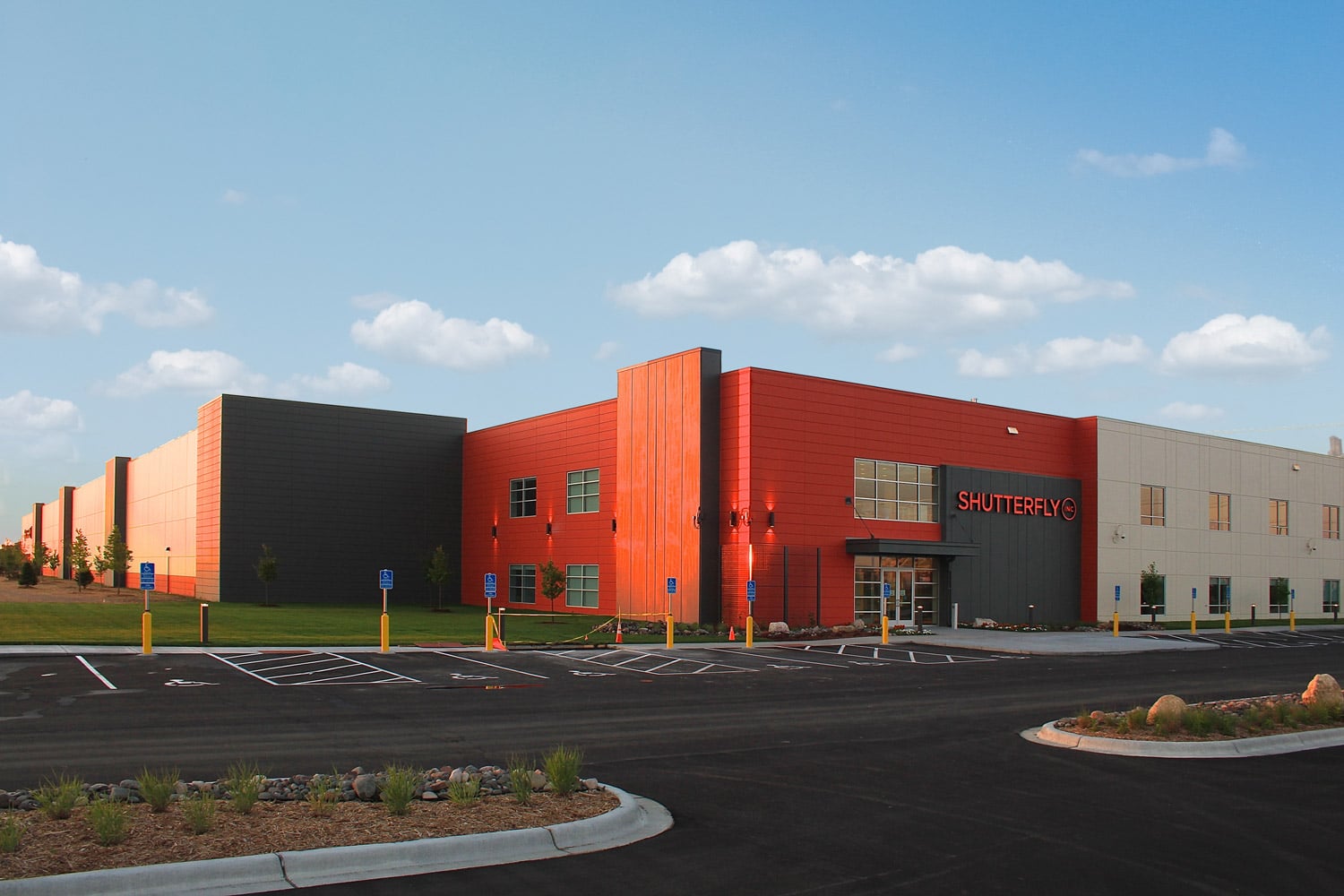
Fabcon’s precast concrete wall panels save projects time and money while being ultra durable and efficient. Photo courtesy of Fabcon
Traditionally concrete is mixed and cast onsite, which can make it difficult to maintain a consistent product quality. Precast concrete slabs and panels, on the other hand, are prepared, cast, and cured in a highly controlled setting and then shipped to the project site. This helps minimize waste production, uses less water than pour-in-place concrete, and reduces the amount of soil and water contamination.
Some precast concrete manufacturers, like Fabcon, also use recycled materials in their precast slabs, which helps keep waste out of landfills and reduces carbon emissions. Today precast concrete is used to build everything from foundations and walls to bridges and even entire buildings.
Pros of Precast Concrete
- Consistent. Because they are produced offsite, precast concrete slabs have a higher degree of quality control and are therefore more uniform in composition.
- Durable. As is the case with poured-in-place concrete, precast concrete slabs are incredibly durable and capable of weathering the elements—and even some natural disasters—with ease; on average precast concrete is designed to last between 50 and 100 years.
- Low maintenance. Once installed precast concrete is incredibly easy to keep clean; if left unsealed precast concrete needs to be power washed once every four to six years, and sealed concrete slabs only need to be hosed down every so often.
Cons of Precast Concrete
- Heavy. Precast concrete slabs are, by nature, extremely heavy. This is only a problem because they have to be shipped to the project site, and their weight can increase shipping times, which in turn increases transportation-related carbon emissions.
- Difficult to alter. Once cast concrete is especially difficult to alter; should any last minute changes need to be made to a project’s dimensions, it can necessitate a complete re-cast or redesign of the slabs themselves.
- Can be tricky to install. Precast concrete slabs are heavy and can be a bit awkward to maneuver, requiring a crane to lower them into place, which can add to the overall construction expenses.
15. Straw Bales
Straw has long-since been used for construction purposes around the world, and straw bales were used to construct houses in Germany as far back as the early 1600s; in the United States, straw-bale construction has been a staple of Nebraskan-architecture since the late 1800s.
Today straw bales are used as both a structural component—stacked in rows to form walls, which are then plastered over—or as insulation. When used structurally straw bales are typically stacked on a foundation and tied together with wire mesh or wood pins before receiving a coat of lime- or clay-based plaster.
Because the plants commonly used for straw—rye, oats, wheat, and rice—are easy to grow, are widely available, contain no toxins, and have low embodied energy, straw bale structures are considered to be very sustainable.
Pros of Straw Bales
- Fire-resistant. Perhaps unexpectedly, straw bales are actually incredibly resistant to fire damage due to how tightly they are compacted; this makes straw bale construction an ideal choice in areas prone to wildfires.
- Good insulator. The density of straw bales also aids in both acoustic and thermal control, which can help dampen sound and reduce the building’s heating and cooling needs.
- Affordable and easy to produce. Raw straw is an inexpensive material and bales are extremely easy to put together—both of which help cut down on overall construction time and costs.
Cons of Straw Bales
- Can attract pests. Depending on the grain content, moisture, and time before it was baled, straw bales can attract a multitude of pests, including both insects and rodents.
- Susceptible to water damage. Should the exterior shell of the structure crack or start to leak, it can allow water to seep in and dampen straw bales, compromising their integrity and promoting mold growth; high humidity can also negatively affect straw bales.
- Not as structurally sound. If built improperly or if constructed on inadequate soil, straw bale buildings can become structurally unsound due to movement of the bales, which can in turn crack plaster or even allow load-bearing walls to collapse; earthquakes and high winds can also negatively impact the structural integrity of straw bale homes.
16. Recycled Plastic
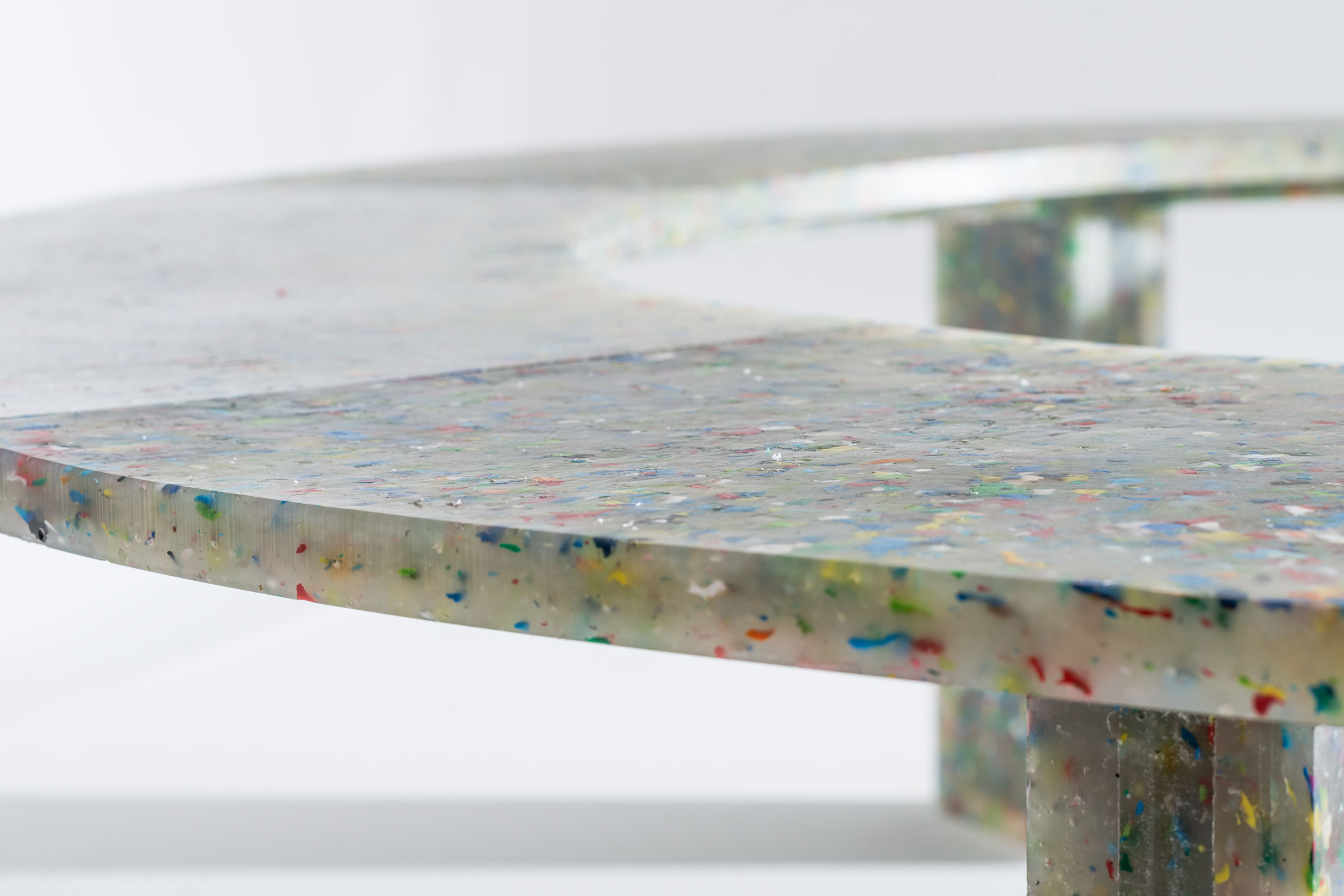
Circula comes in recycled plastic designed in collaboration with Boomplastic. Photo courtesy of Studio Rygalik
On average the United States produces approximately 40 million tons of plastic waste each year—and roughly 85% of that waste ends up in landfills. Due to its abundance and long lifespan, recycled plastic has high potential for use in construction and design: it can be molded into shingles, added to concrete, incorporated into roadways, formed into bricks or tiles, and even used to make recycled-fiber carpets.
As it stands there is already too much plastic on earth and more is being made each year. Recycling existing plastic for mass use in construction projects is one way to help reduce the need for new plastic production.
Pros of Recycled Plastic
- Long-lasting. Plastic is somewhat infamous for its incredibly long lifespan, but this can actually be a plus when recycled plastic is used in construction, as it reduces the need for maintenance and replacement, saving costs in the long run.
- Easily molded. Recycled plastic can very easily be molded into a variety of shapes, a quality that gives it an almost endless array of design possibilities.
- Water- and pest-proof. Recycled plastic is waterproof and does not attract pests like termites or mice.
Cons of Recycled Plastic
- Inevitably produces microplastics. Over time and with use recycled plastic products shed microscopic plastic particles; these microplastics end up in the soil, air, and water and can leach harmful chemicals into the environment.
- Thermal expansion and contraction. If regularly exposed to fluctuating temperature changes, recycled plastic building materials can expand and contract at a rate that compromises their structural integrity.
- Low load-bearing capacity. While durable, recycled plastic doesn’t have very high compressive strength, making it unsuitable for load-bearing features like columns or beams.
17. Plant-based Polyurethane Rigid Foam
Plant-based polyurethane rigid foam is one of the leading sustainable alternatives to rigid foam insulation. Unlike its predecessor, PPRF does not contain chlorofluorocarbons—a group of compounds that contribute to anthropogenic climate change—making it much better for the environment.
Plant-based polyurethane rigid foam is produced using either a combination of hemp, kelp, and bamboo or vegetable oil and is primarily used as insulation, though it can also be used in furniture.
Pros of PPRF
- High thermal resistance. Plant-based polyurethane rigid foam has high thermal resistance, making it an ideal insulator. It’s so good, in fact, that PPRF has a higher R-value than polystyrene and fiberglass insulation.
- Can be composted. Unlike traditional rigid foam, most PPRF products can be composted at the end of their life-cycle; this helps keep construction waste out of landfills.
- Lower carbon emissions. Generally speaking, plant-based polymers are easier to extract than petrochemical-based polymers and subsequently require less energy to manufacture, thereby reducing overall carbon emissions.
Cons of PPRF
- Expensive. Compared to traditional polyurethane foam, PPRF is significantly more expensive; on average one kilogram of PPRF costs between $18 and $19.15.
- Harder to come by. PPRF is a relatively new material, one that is still being tested and improved upon; as such it can be difficult to find a local supplier, which can increase a project’s overall construction time and costs.
18. Natural Fiber Insulation
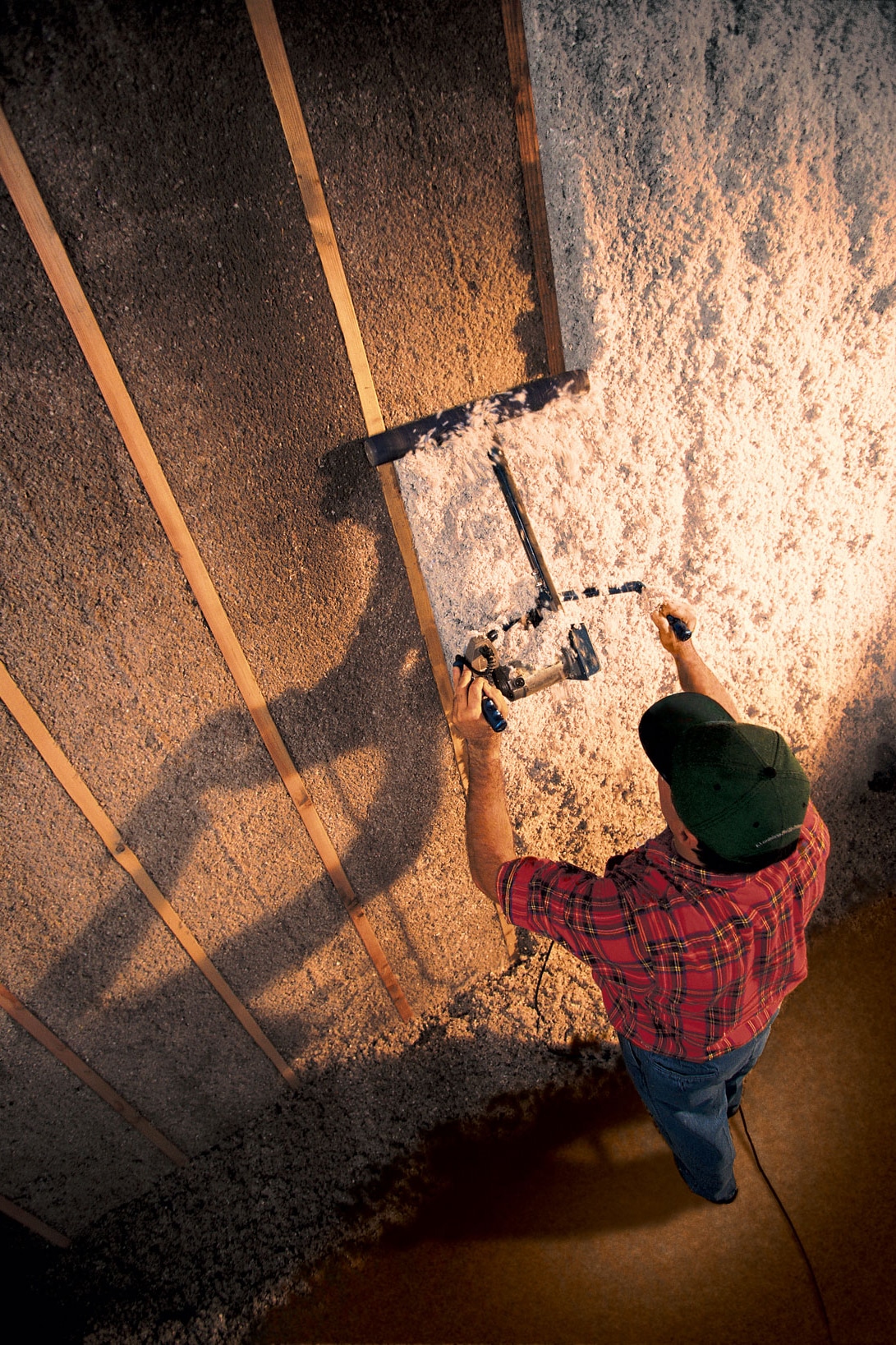
Greenfiber’s wall insulation starts as a plant material, is made into paper, and reused as insulation. Photo courtesy of Greenfiber
Intended as alternatives to conventional chemical- and mineral-based insulations, natural fiber insulations encompass a range of organic compounds with natural insulative properties, including such materials as hemp, cotton, wood fiber/cellulose, straw, wool, etc.
For the most part natural fiber insulation is safer to handle and install than traditional fiberglass insulation, as they typically contain fewer irritants and chemicals. Natural fiber insulation also boasts a lower carbon footprint and produces less waste—qualities that many natural fiber insulation companies, like Greenfiber, pride themselves on.
“Greenfiber uses a low-energy manufacturing process that results in materials with the least-embodied energy of most major insulation products. The production process generates little no waste or byproducts because we leverage recovered material to start with,” Jason Todd, the director of market development and building science at Greenfiber, previously told gb&d.
Pros of Natural Fiber Insulation
- Low- or zero-VOC. Generally speakin- natural fiber insulation contains fewer volatile organic compounds (VOCs) than traditional mineral or chemical insulations, which helps improve indoor air quality and long-term occupant health.
- Fire resistant. Many natural fiber insulations possess natural flame retardant qualities, which helps slow the spread of fire and allows more time for occupants to escape; natural fiber insulations that aren’t intrinsically fire resistant are made so after the fact through the addition of borate.
- Temperature regulation. Natural fiber insulations are adept at regulating interior temperatures, which helps reduce a built structure’s heating and cooling needs.
Cons of Natural Fiber Insulation
- Can be expensive. Some types of natural fiber insulation, such as sheep’s wool or cotton, are more expensive than their chemical- and mineral-based counterparts.
- May not be as effective. While all natural fiber insulations offer some measure of temperature regulation, most are not as effective as conventional fiberglass insulation—at least, not per inch of insulation material, anyway.
- May require more material. For natural fiber insulation types with lower R-values—that is, insulative capabilities—more insulation material is required to bring it up to par with traditional insulation types; thicker layers of insulation means thicker walls, which can encroach on usable floor space.
19. Mycelium
Mycelium refers to the microscopic network of hyphae strands that make up the vegetative tissue of fungal colonies. When mycelium spores are introduced to organic waste, they quickly grow and send out roots that then consume the waste until all that’s left is a block of mycelium.
This block of mycelium can then be carved or broken into smaller pieces and set in molds to form bricks—some companies, like the New York–based Ecovative Design, even use mycelium to create foam insulation.
Due to its rapid growth rate, consumption of waste material, non-toxicity, and low-emission production, mycelium is an incredibly sustainable material.
Pros of Mycelium
- Highly insulative. Thanks to its molecular composition, mycelium has naturally high insulative properties—it isn’t flammable, effectively regulates temperature, and acts as an acoustic dampener.
- Biodegradable. Mycelium as a building material is 100% biodegradable and can be composted once it outlives its construction purpose, thereby reducing demolition waste.
- Easily produced. One of the hallmarks of mycelium is that it is both quick and easy to produce, without generating waste or harmful emissions in the process.
Cons of Mycelium
- Low compressive strength. Compared to traditional building materials like concrete or stone, mycelium has a very low compressive strength; as such, mycelium bricks cannot be used as load-bearing supports.
- Susceptible to moisture. When regularly exposed to moisture—even just ambient humidity—mycelium becomes less structurally sound and starts to break down.
- Shorter lifespan. As mycelium becomes less resistant to moisture over time, it becomes more vulnerable to damage from humidity and mold. As a result mycelium has a shorter lifespan than many other building materials.
20. Green Concrete
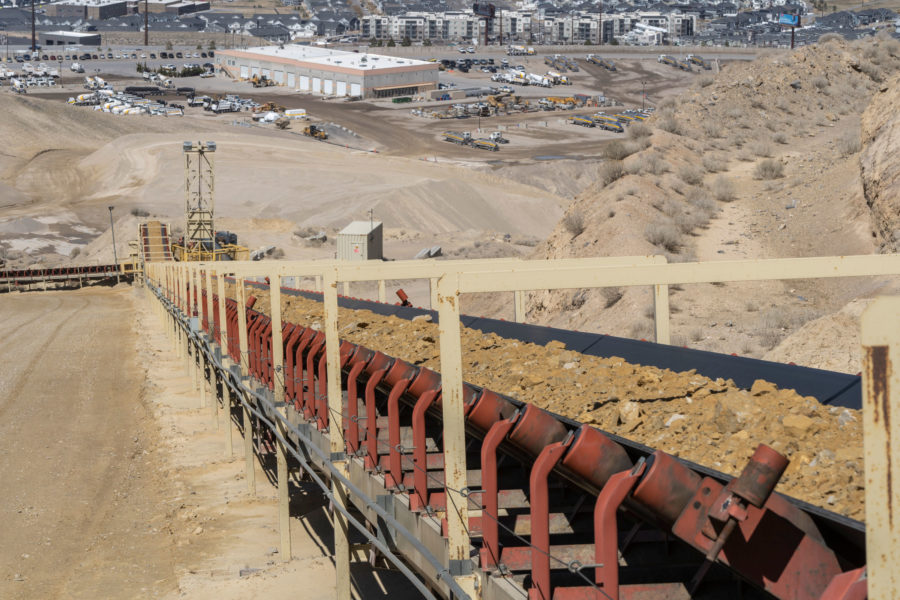
Photo courtesy of Geneva Rock
While the term “green concrete” can apply to any concrete that includes added measures to reduce its environmental impact, it typically refers to concrete that contains a high percentage of recycled waste materials like fly ash, silica dust, slag, and even previously-cast concrete aggregate.
“Rather than dumping asphalt and concrete from construction demolition into landfills, we recycle those materials to be used in future projects,” Nathen Schellenberg, vice president of specialty construction at Geneva Rock Products, previously wrote for gb&d. “On average Geneva Rock recycles 1 million tons of asphalt, concrete, and other aggregate materials every year.”
Green concrete can be used in construction in much the same ways as traditional concrete and has been utilized to construct everything from bridges and buildings to dams and other infrastructural projects.
Pros of Green Concrete
- High thermal resistance. Like traditional concrete, green concrete has a high thermal resistance and is capable of absorbing and storing heat; when incorporated into passive solar design, green concrete can significantly help reduce heating and cooling requirements.
- Utilizes recycled materials. Green concrete makes significant use of recycled materials and helps keep waste out of landfills.
- Low carbon emissions. On average the mixing of green concrete produces 80% fewer carbon emissions than traditional concrete, as less energy is required to break down the materials.
Cons of Green Concrete
- Higher reinforcement costs. Most green concrete is reinforced with stainless steel, which typically costs more than the carbonized steel rebar used to reinforce conventional concrete.
- Lower compressive strength. In most cases, green concrete has a lower compressive strength than normal concrete, which means it cannot safely support as much weight.
21. Ferrock
Designed as a substitute for conventional cement, ferrock is a concrete-like substance produced by mixing recycled ground-up glass and steel dust with water and ferrous (iron-rich) rock. Once combined, this mixture is then poured and exposed to carbon dioxide, at which point iron carbonate forms, effectively trapping carbon in the ferrock.
After it sets ferrock becomes extremely strong and can be used for construction in all the same ways that concrete can be used. Due to the fact that ferrock is resistant to both chloride and sulfate damage, it can even be used in construction projects that come into contact with saltwater—a marked improvement over traditional concrete, which erodes in saltwater.
Pros of Ferrock
- Incredibly durable. Thanks to its unique composition, ferrock is resistant to rot, corrosion, chemical exposure, oxidation, rust, and even UV damage; ferrock is also five-times stronger than conventional concrete and has a higher compressive strength.
- Absorbs carbon dioxide. While it’s true that ferrock produces carbon during its production process, it makes up for it by absorbing a higher quantity of carbon as it dries, effectively making ferrock a carbon negative material.
- Utilizes recycled waste. On average 95% of the materials used in ferrock come from recycled waste products like silica and steel dust.
Cons of Ferrock
- Not suitable for large projects. Ferrock requires a ready supply of silica and steel dust, both of which typically aren’t available in large quantities; as such, ferrock is better suited to small-scale projects.
- Steel dust can become costly. If ferrock becomes more popular, the cost of steel dust is likely to increase, which can make it harder and more restrictive to come by.
- Lack of experience. Due to the fact that ferrock is a pretty modern invention and hasn’t been widely adopted, it can be hard to find construction crews with the necessary experience to create and work with ferrock.
22. Smart Glass Windows
As perhaps the most technologically advanced material on this list, smart glass windows are a truly innovative way for building’s to make the most efficient use of natural light and solar heat.
Also referred to as switchable glass, smart glass windows are constructed using a type of glass that allows for adjustment of the window’s reflective properties. Currently, there are two categories of smart glass windows: electrically switchable and thermochromic.
Electrically switchable smart windows use either micro-blinds, polymer-dispersed liquid-crystal devices, suspended-particle devices, or electrochromic devices to actively adjust the opacity of the glass when an electric charge is applied. Thermochromic smart glass windows, on the other hand, use what is called a phase-changing polymer to passively adjust the window’s opacity once the glass reaches a certain temperature.
Pros of Smart Glass Windows
- Blocks UV rays. Smart glass windows are capable of blocking 95% of all UV-rays without actually reducing the amount of natural light they let in; this also helps minimize glare.
- Energy efficient. When switched to the opaque setting, smart glass windows reduce the amount of incoming solar heat, which can greatly reduce a building’s need for air conditioning.
- Provides privacy. An added benefit of smart glass windows—especially electrically switchable windows—is that they provide privacy when switched to the opaque setting, making them ideal for use in office buildings.
Cons of Smart Glass Windows
- Expensive. Compared to traditional windows, which typically only cost between $10 and $15 per square foot, smart glass windows are significantly more expensive—on average, expect to pay between $50 and $150 per square foot.
- Requires specialized installation. Due to the fact that smart glass windows are more complex than standard windows, they require experienced professionals to install them; this can raise a project’s overall construction costs.
- Some require electricity. As it currently stands the most popular types of smart glass windows are those that require an electric charge to switch between transparent and opaque; this can reduce the amount a building saves on energy costs by installing smart glass windows.
23. Reclaimed & Recycled Steel
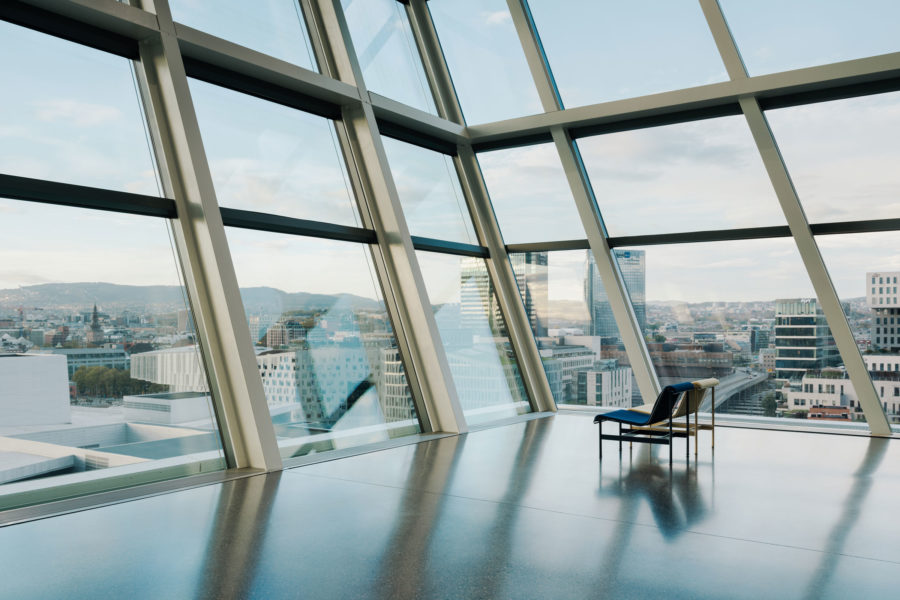
Low-carbon concrete, a compact shape, high-quality windows, steel and natural ventilation are all elements of the new Munch Museum. The building is connected to a district-heating system and a seawater cooling plant and features an energy control system that optimizes energy consumption. The building has no parking spaces, given its location close to the city’s largest public transport hub and 100 cycle-parking spaces. Photo by Einar Aslaksen
When a building or infrastructural project is demolished, it leaves behind a lot of material, especially when it comes to steel, which is one of the most popular contemporary building materials and often used as the structural framework for large buildings. Approximately 90% of the steel used in built structures can be recycled and reused in other projects, either as is (columns, beams, etc.) or, in the case of scrap steel, after being melted down and re-forged.
Ultimately this helps keep a significant amount of waste out of landfills and reduces the amount of emissions produced by the steel industry.
Pros of Recycled Steel
- Reduces waste. The most obvious benefit of using reclaimed or recycled steel is that it reduces demolition waste and extends the lifespan of existing products—which is almost always more sustainable than manufacturing new ones.
- Saves money. Even though reclaimed steel is practically identical to new steel in terms of quality, it is significantly less expensive, thereby decreasing a project’s overall construction costs.
- Durable. Just like new steel, recycled steel is an incredibly durable material with a very high load-bearing capacity, making it suitable for large construction projects; steel can withstand everything from severe weather to earthquakes and has an average lifespan of 50 to 100 years.
Cons of Recycled Steel
- Difficult to alter. Once steel has been cast and prepped for construction, it is very difficult to make changes after the fact; if recycled steel is available, it may not be the correct size or shape, which can increase overall construction time and costs should alterations become necessary.
- High maintenance. As is the case for any steel product, recycled steel requires frequent maintenance and routine painting to keep it free of rust and corrosion.
- High thermal conductivity. Steel in any form is highly conductive of heat; when it is used as a building’s framework, it can pose both an increased fire hazard and often results in higher cooling loads, thereby increasing energy-related costs.
24. Rammed Earth
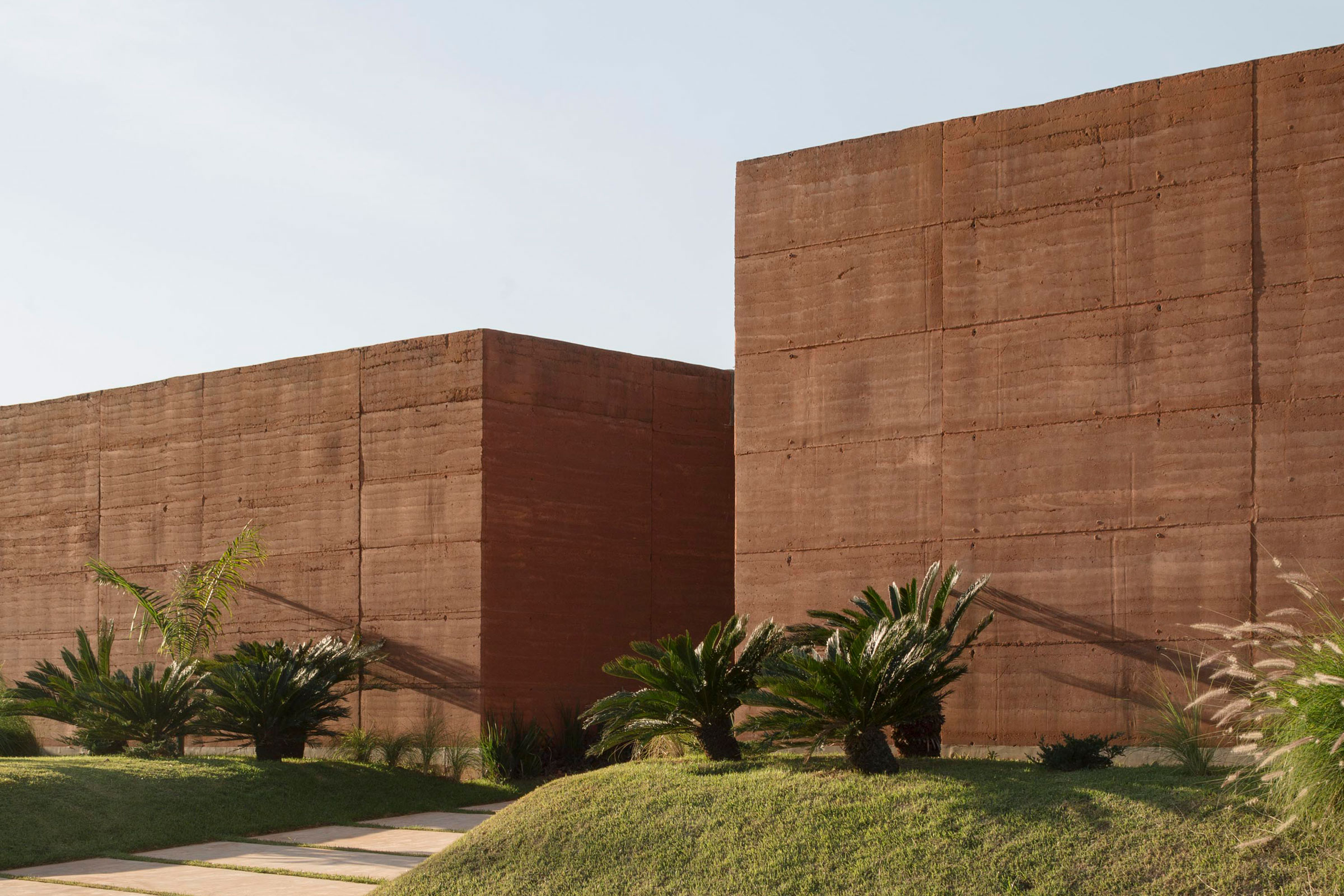
Rammed earth blocks make up the walls of the Child Care Center, an alternative daycare in Villeta, Paraguay designed by Equipo de Arquitectura. Photo by Federico Cairoli
As one of the most abundant materials on the planet, it’s only fitting that dirt—or more accurately, rammed earth—is on this list.
Constructed by gradually pouring a damp mixture of selected aggregates (typically dirt, sand, silt, gravel, and clay) in between flat panels or into a flooring mold and then compacting it in successive layers, rammed earth is an age-old building practice that has since undergone a modern revival. Cement or lime is often added as a stabilizer to help improve the load-bearing capacity of rammed earth walls.
As long as adequate subsoil is available, rammed earth structures can be built in just about any biome, even those that receive regular rainfall—provided, of course, that they are properly maintained.
Pros of Rammed Earth
- Readily available. Generally speaking, rammed earth constructs are created using locally sourced and easily extracted renewable materials, which significantly reduces a project’s carbon emissions and construction waste.
- Durable. The very nature of rammed earth makes it an extremely durable material, one that can withstand inclement weather, fires, and even seismic activity with ease; if properly constructed, rammed earth structures can last for thousands of years.
- High thermal mass. Similar to concrete rammed earth has a high thermal mass, which means it is extremely capable of absorbing heat during the day and then releasing it at night; this can help improve energy-efficiency and reduce the heating and cooling loads of a structure.
Cons of Rammed Earth
- Long curing times. Once the form is removed from around a rammed earth wall, it usually takes a full month for the wall to cure and harden completely, which can extend construction time significantly.
- May require additional insulation. Rammed earth’s high thermal mass can help regulate interior temperatures, but it often needs added insulation when built in colder climates.
- Limited uses. Due to the nature of how rammed earth is formed, most structures featuring rammed earth walls are limited to one story (maybe two, if you’re lucky) and are confined to simple floor-plan shapes.
25. Composite Roofing Shingles
The recycled waste in composite roofing shingles also makes it a sustainable material.
Unlike traditional asphalt shingles, composite shingles are produced by combining recycled waste (typically plastic and rubber) with other materials like laminate, wood, and synthetic polymers. Most companies mold their composite shingles off of real slate or cedar shingles, which makes the end result a convincing replica of a much more expensive roofing material.
However, not all composite shingle manufacturers use recycled materials in their products, so you should verify before making your choice.
Pros of Composite Roofing Shingles
- Durable. Due to their composition, composite shingles are extremely durable and have a very high impact rating, which means you won’t have to worry about severe weather damaging them; on average, you can expect composite shingles to last for fifty years.
- Low maintenance. While this is true of most modern shingles, composite shingles are very easy to take care of. All that’s required is periodic washing with soap and water.
- Versatile design options. Composite shingles can be made to look like aesthetically pleasing cedar and slate shingles, but they also come in a variety of colors, making it easier to customize a building’s exterior.
Cons of Composite Roofing Shingles
- Shorter lifespan than true slate. Composite shingles typically last longer than traditional asphalt shingles, but they don’t last as long as the slate shingles they’re designed to emulate, which means they’ll need to be replaced more frequently.
- More expensive than traditional shingles. This is both a pro and a con in the sense that, yes, composite shingles are more expensive than conventional shingles, but they also last longer, which more or less makes up for the added upfront cost.
- Harder to find. Due to the fact that composite shingles are a fairly recent innovation in the roofing industry, it can be difficult to find companies and contractors that actually offer them.
Are Sustainable Materials Nontoxic?
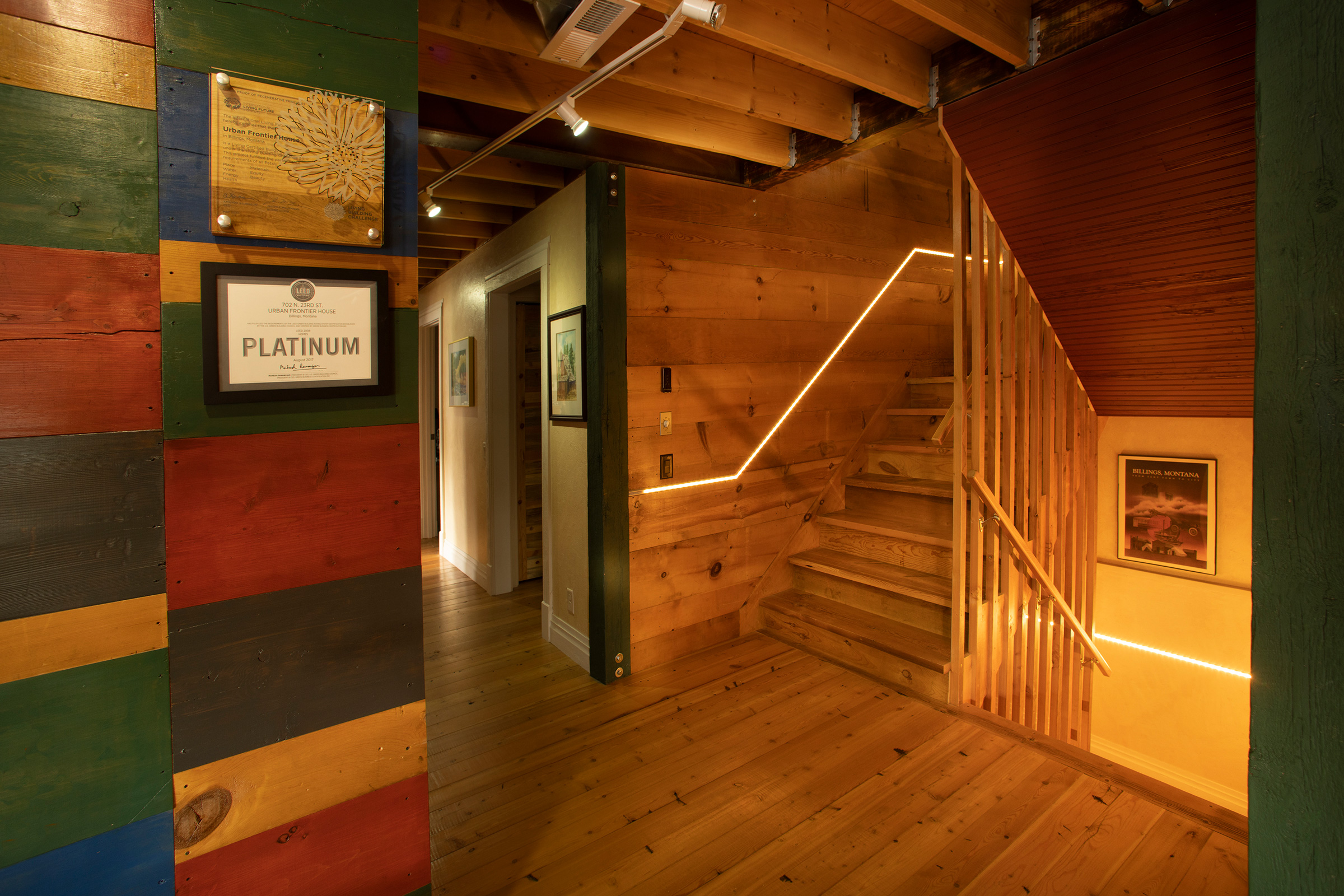
The wood products and paint used throughout Urban Frontier House are all free of Red List ingredients. Photo by Clark Marten
Generally speaking sustainable materials strive to be as nontoxic as possible and many natural building materials have no toxins whatsoever. This does not, however, mean that all sustainable materials are completely free of toxic or caustic compounds.
Many natural fiber insulations, for example, require treatment with borate to protect them from pests, and most sustainable concrete alternatives still contain lime, a caustic compound that can cause chemical burns. It’s always a good idea to check whether a material contains toxic or otherwise dangerous chemicals before implementing it in a project.
One of the easiest ways to verify that a building material or product does not contain harmful ingredients is to look for a Red List Free label. Compiled by the International Living Future Institute, the Red List is a comprehensive guide to the so-called “worst in class” chemicals, materials, and elements known to cause serious harm to human and ecosystem health.
All products bearing a Red List Free label fully disclose 100% of their ingredients at or above 100ppm and do not contain any of the chemicals on the Red List.
Are There Alternative Sustainable Materials for All Building Materials?

Covestro offers MDI—a core component of high efficiency rigid polyurethane insulation—in a climate neutral version through the use of bio-waste as an alternative raw material. Photo courtesy of Covestro
There isn’t a readily available sustainable alternative for each type of building materials, but the industry is moving in that direction. More sustainable alternatives are being developed and experimented with every year.
As the number of sustainable building materials increases, the easier it becomes to replace conventional construction products with environmentally friendly alternatives—without compromising the structure’s integrity or its occupants’ health in the process.
Conclusion
Incorporating sustainable building materials into your next project is one of the easiest ways to reduce a structure’s long-term environmental impacts, as sustainable materials typically require less energy to produce, minimize or reuse construction waste, and often aid in the sequestering of carbon emissions.
Sustainable building materials also help save money in the long run, even if they sometimes have higher upfront costs, as they are designed with durability in mind and often have very long lifespans compared to their non-sustainable counterparts.
At the end of the day, your project, its occupants, future generations, and the planet all benefit from the use of sustainable building materials.

